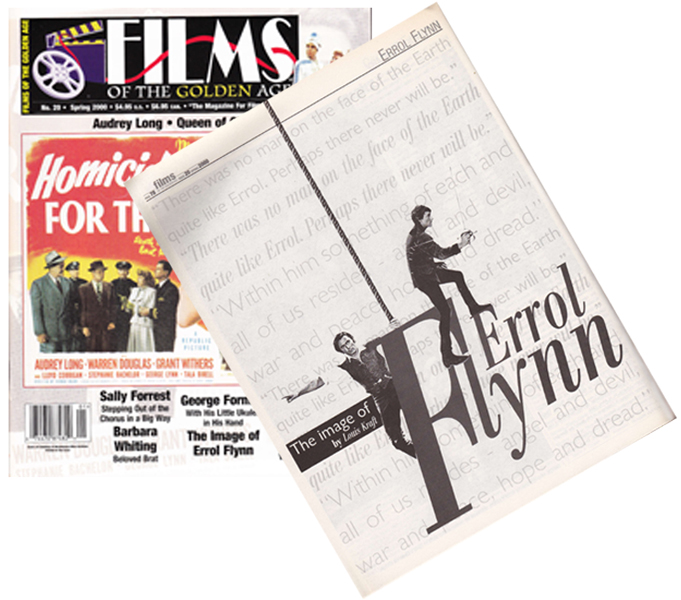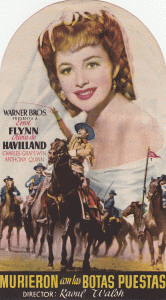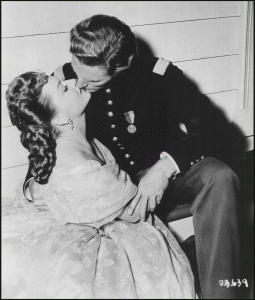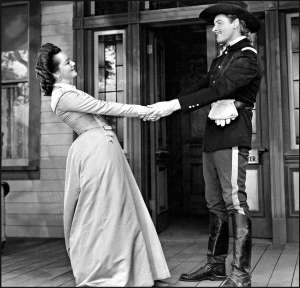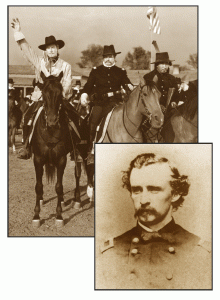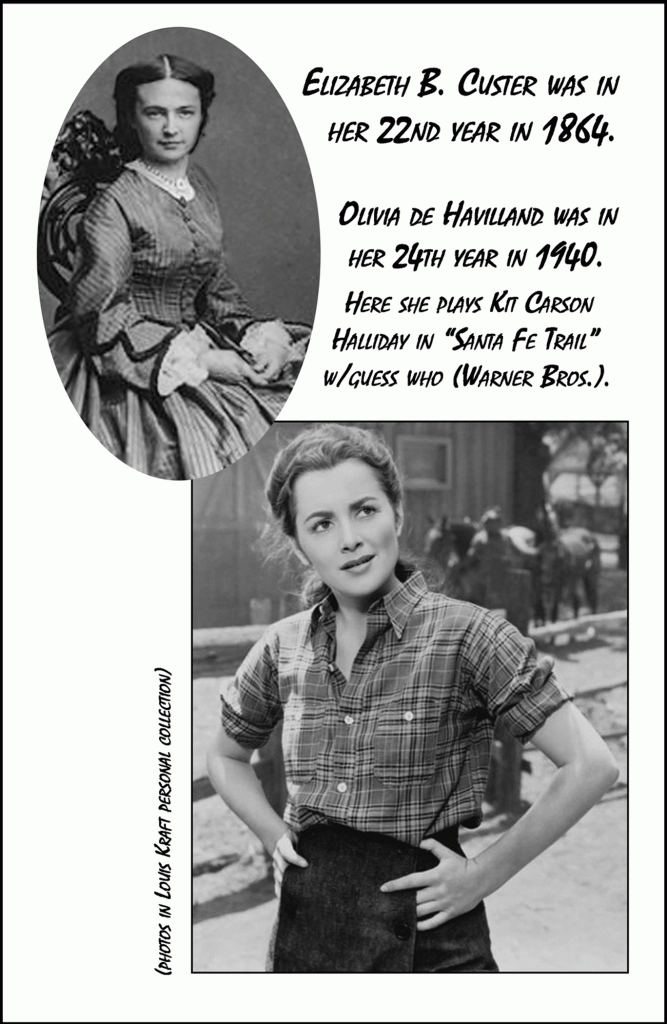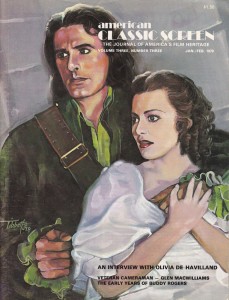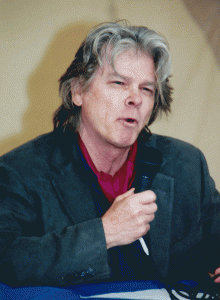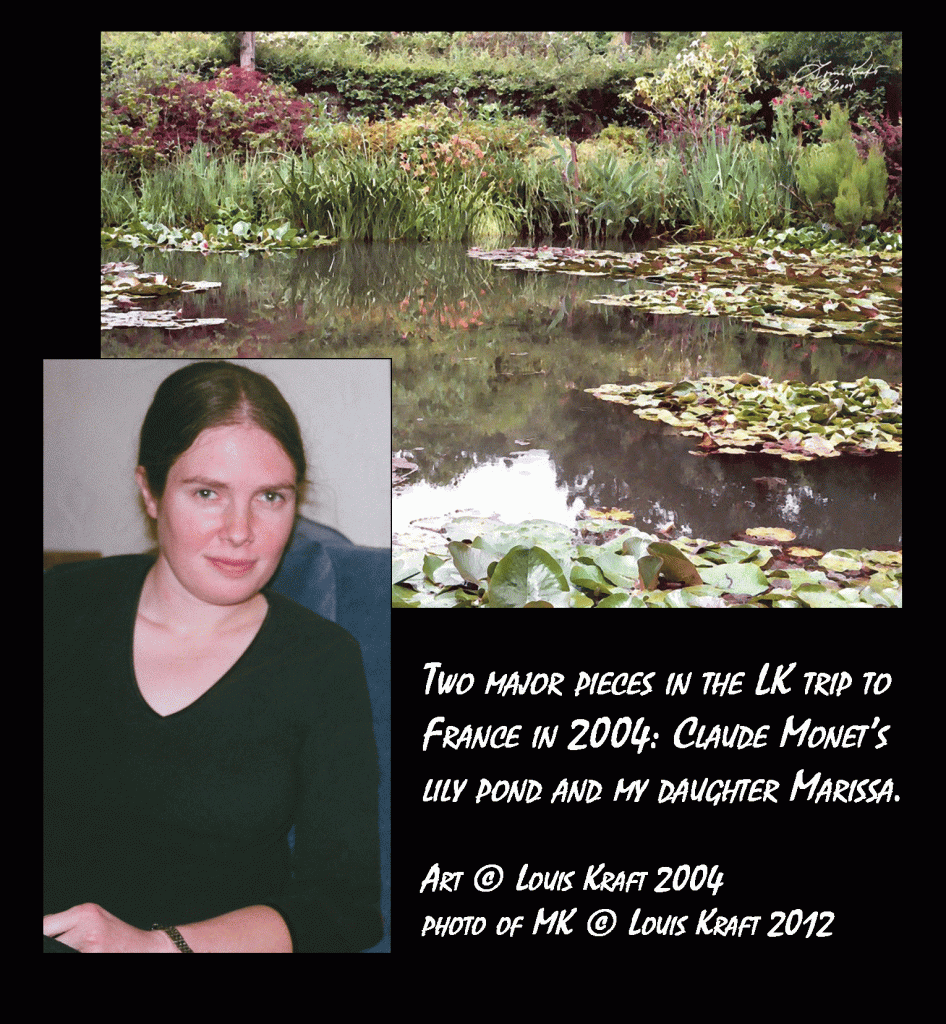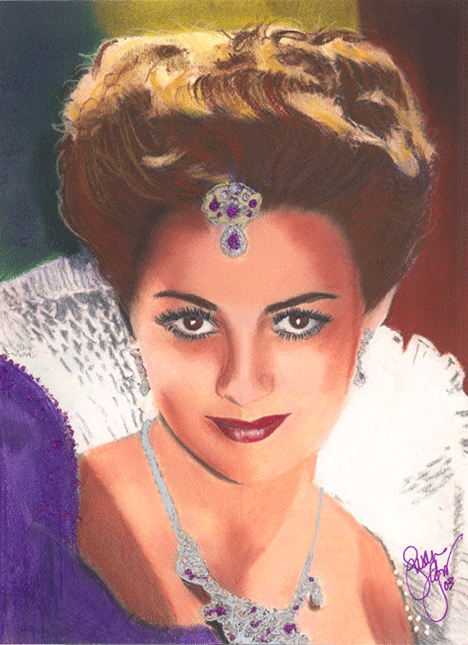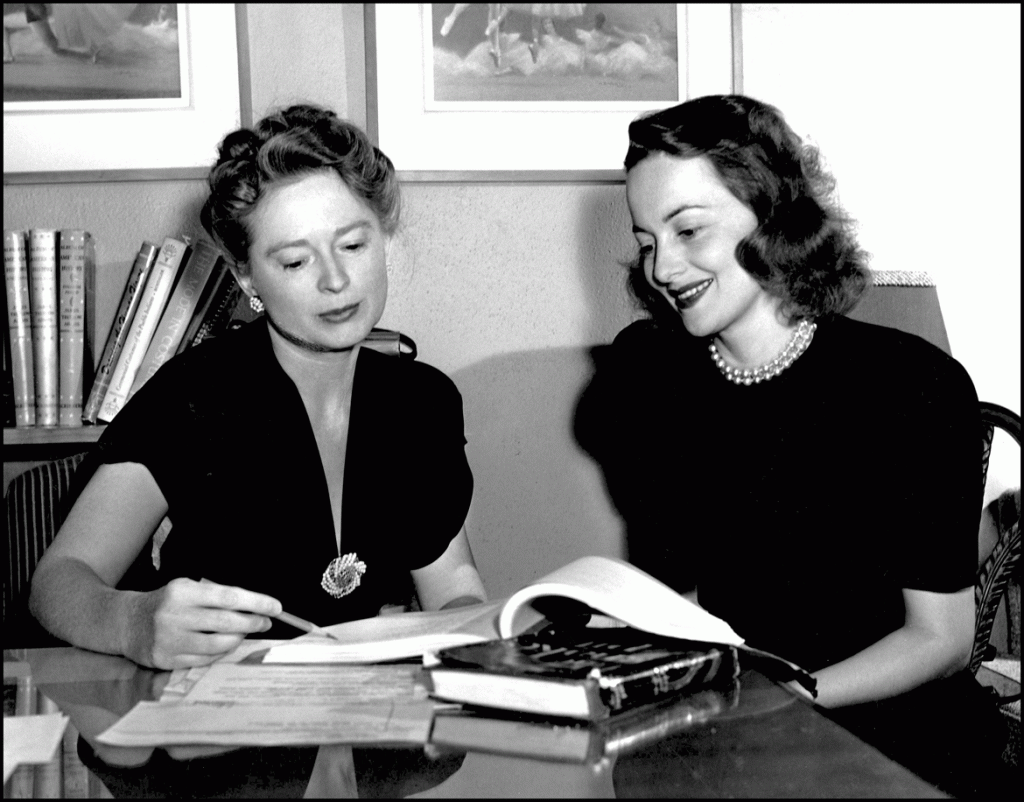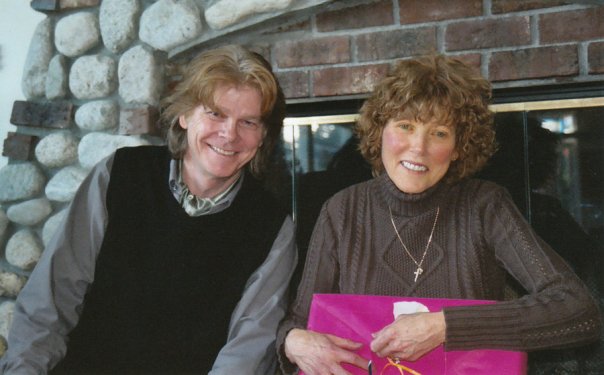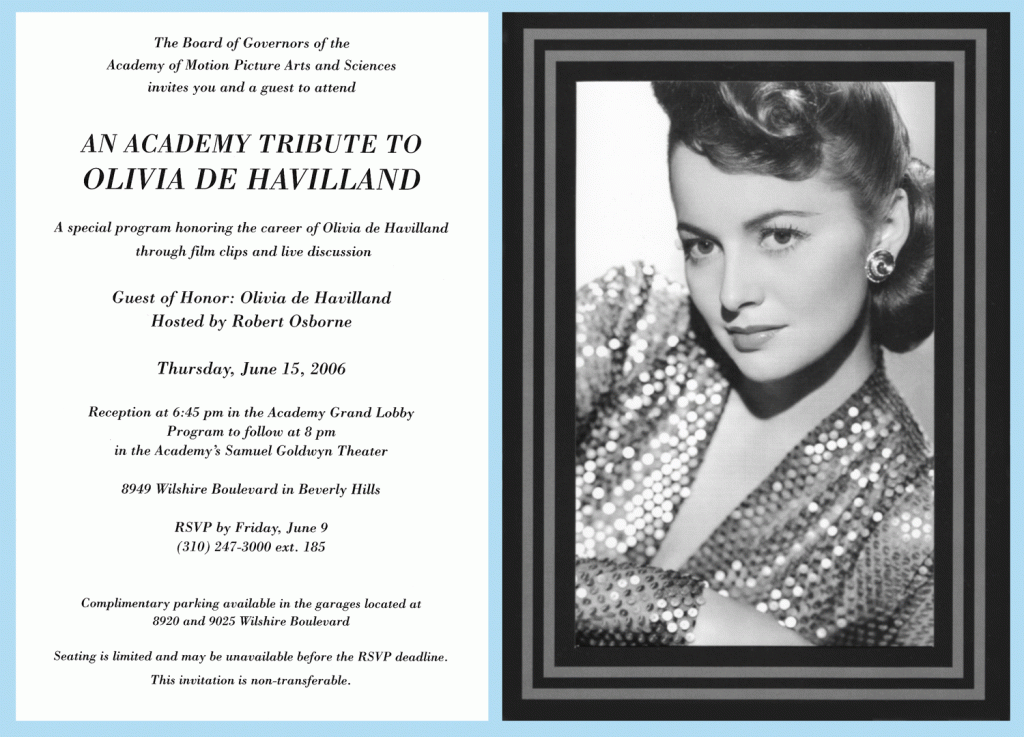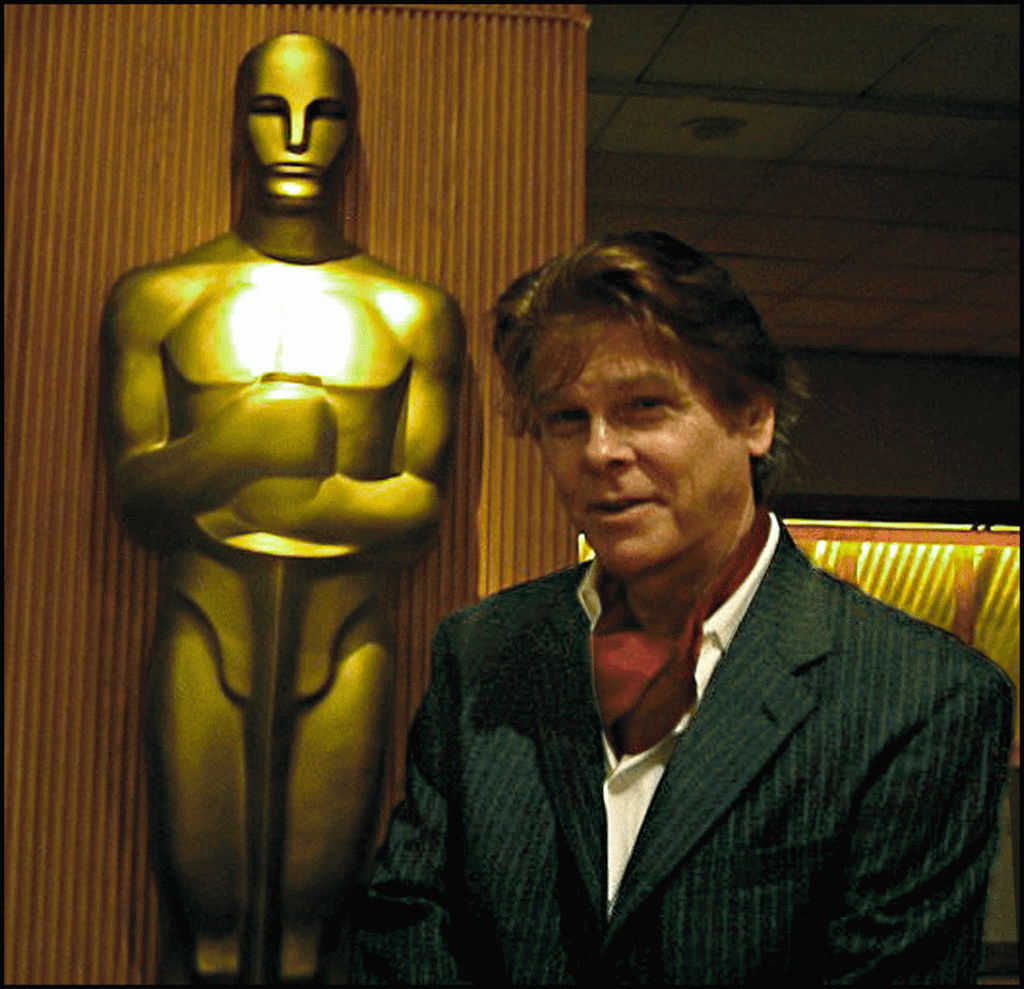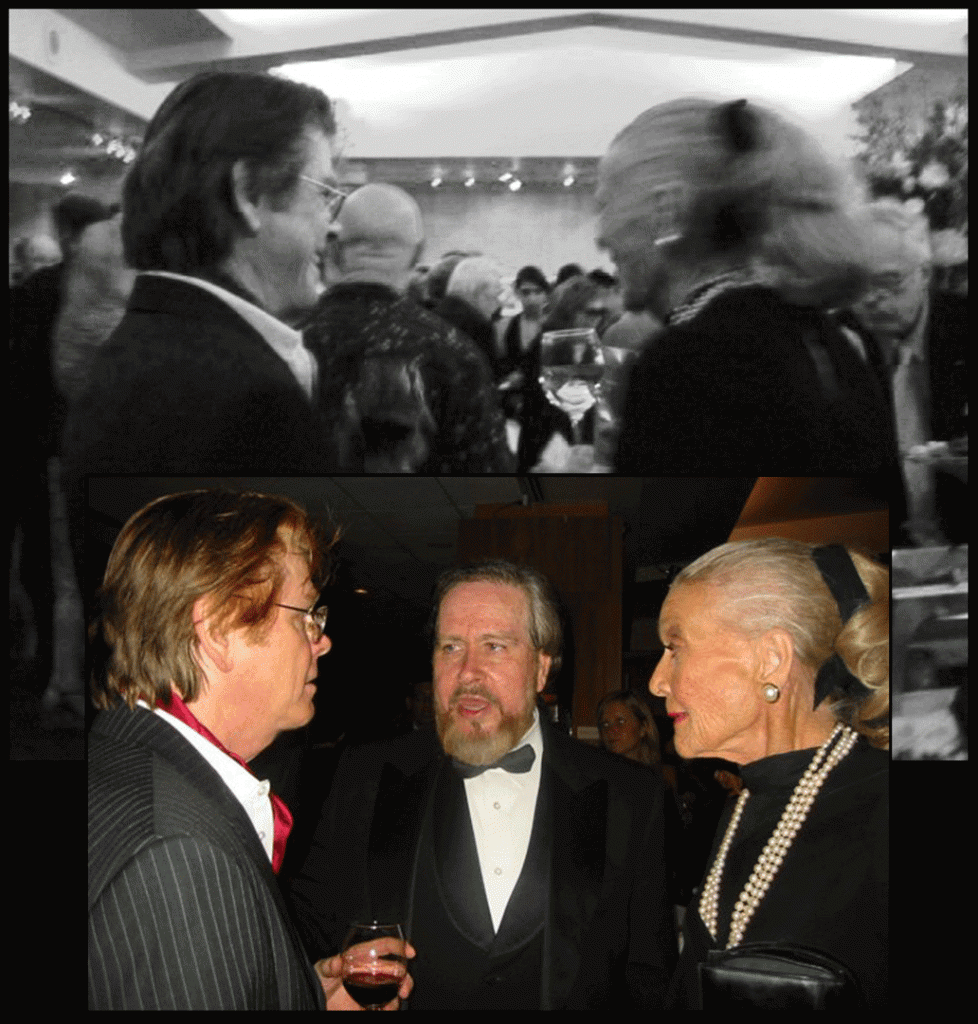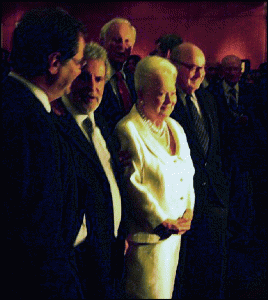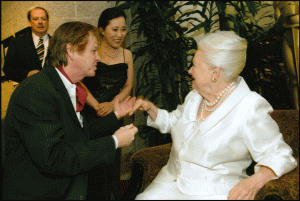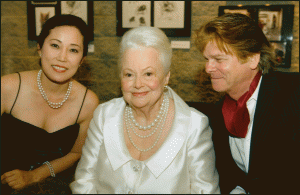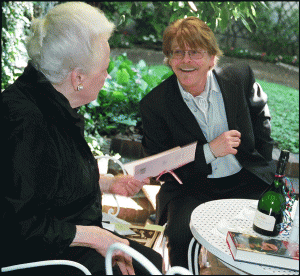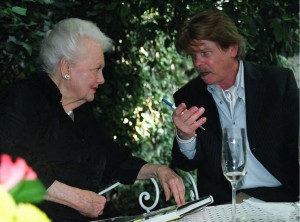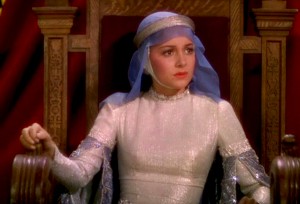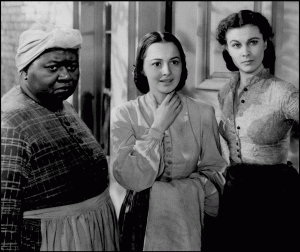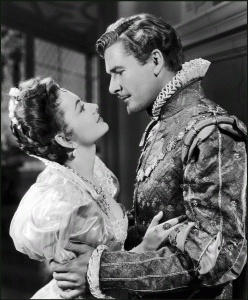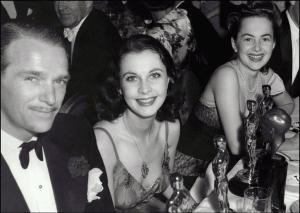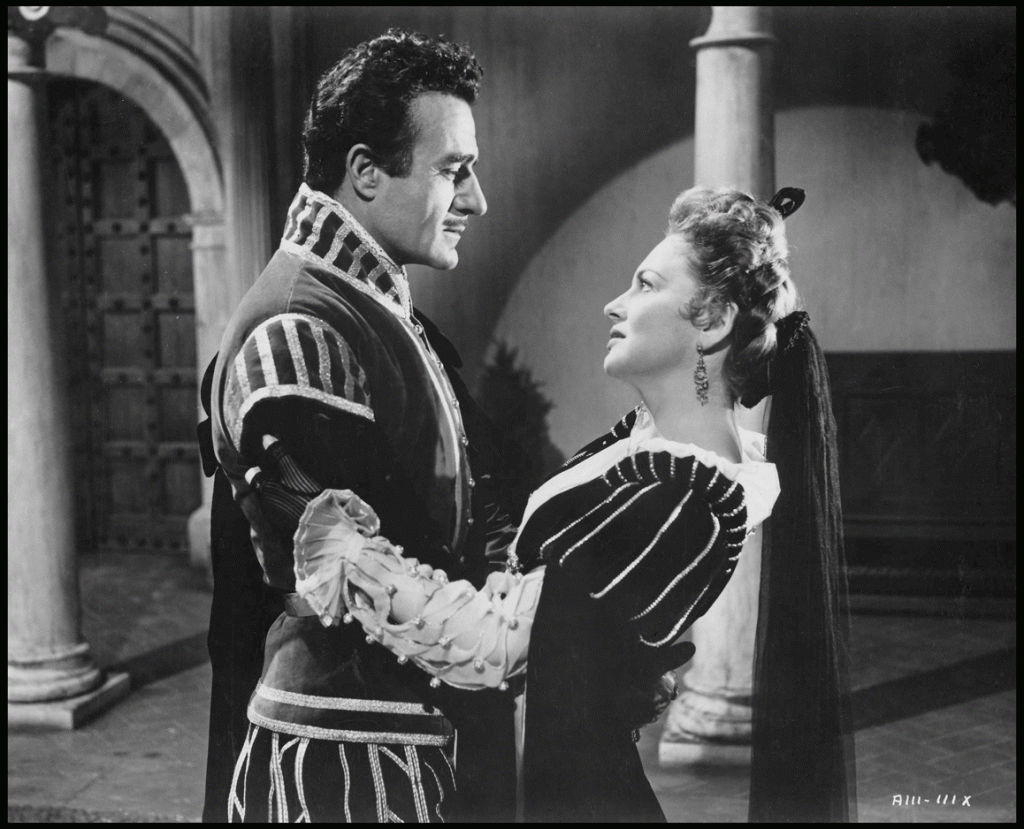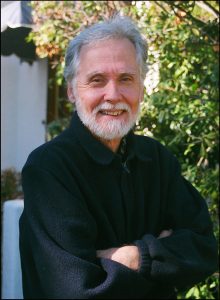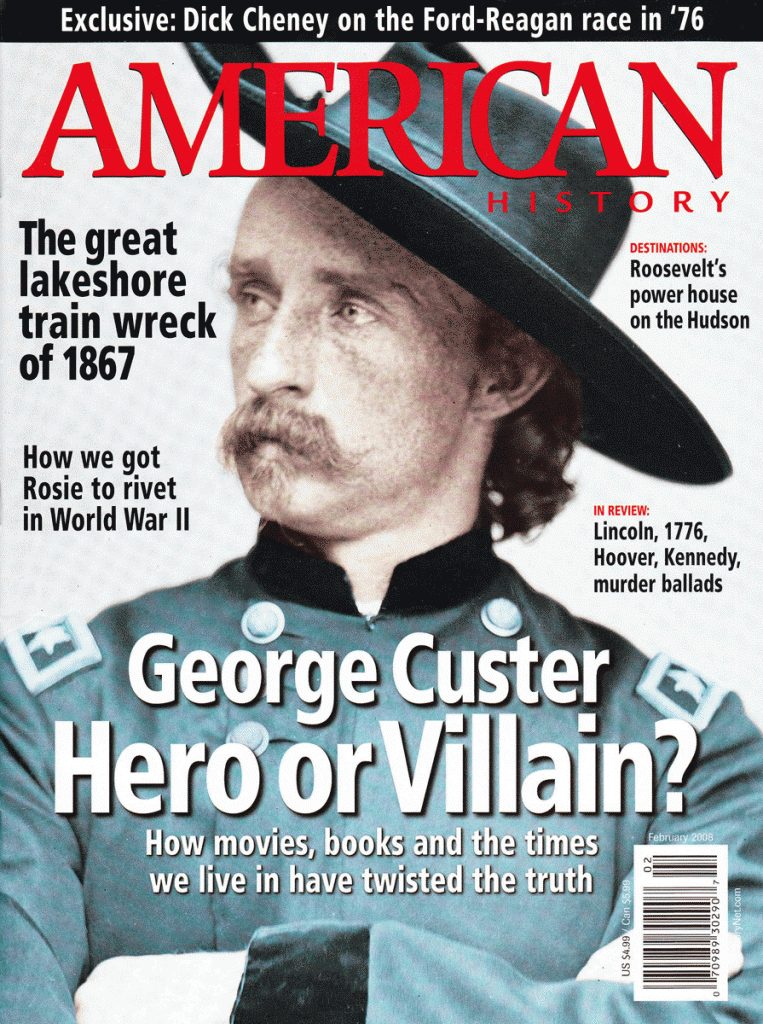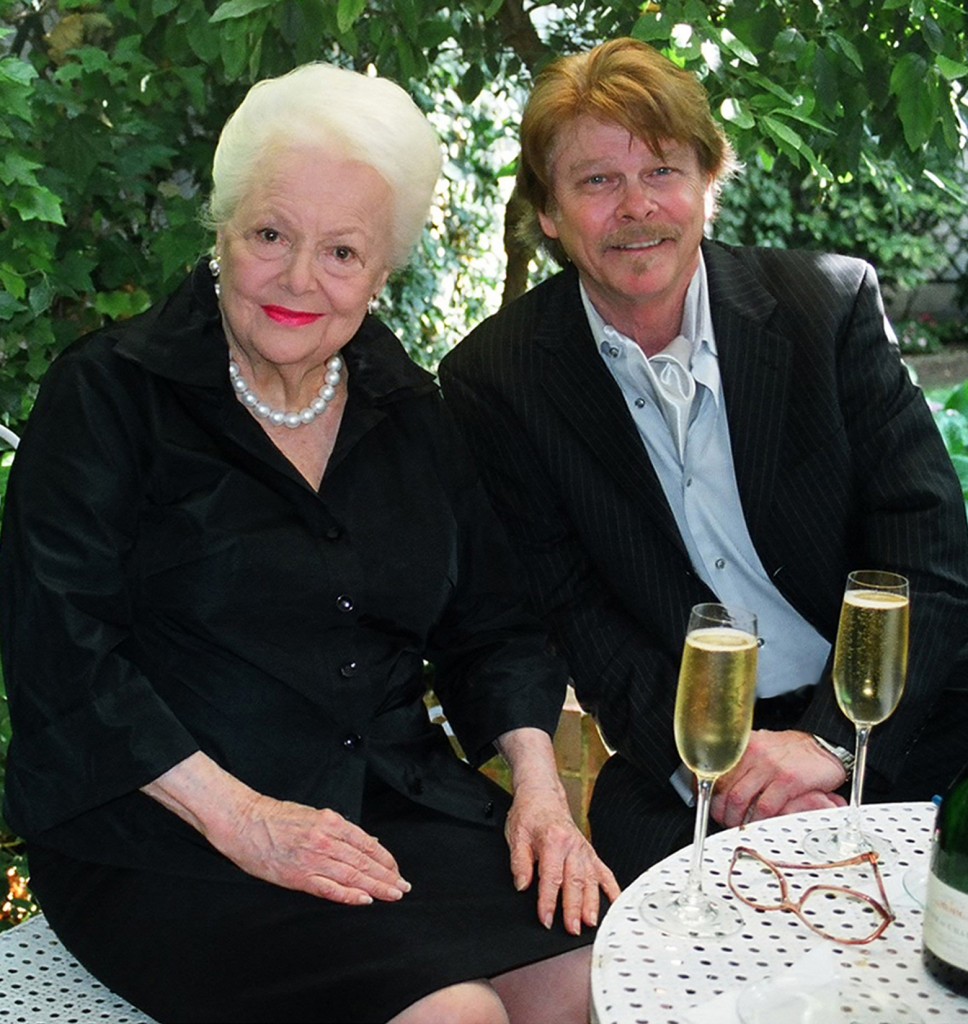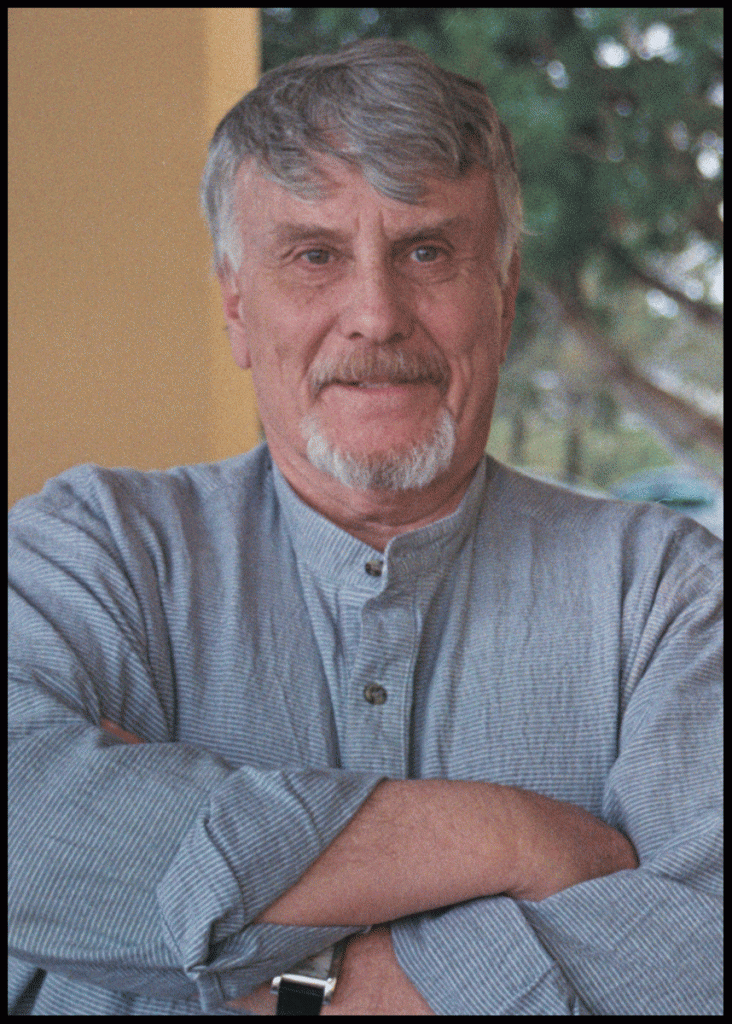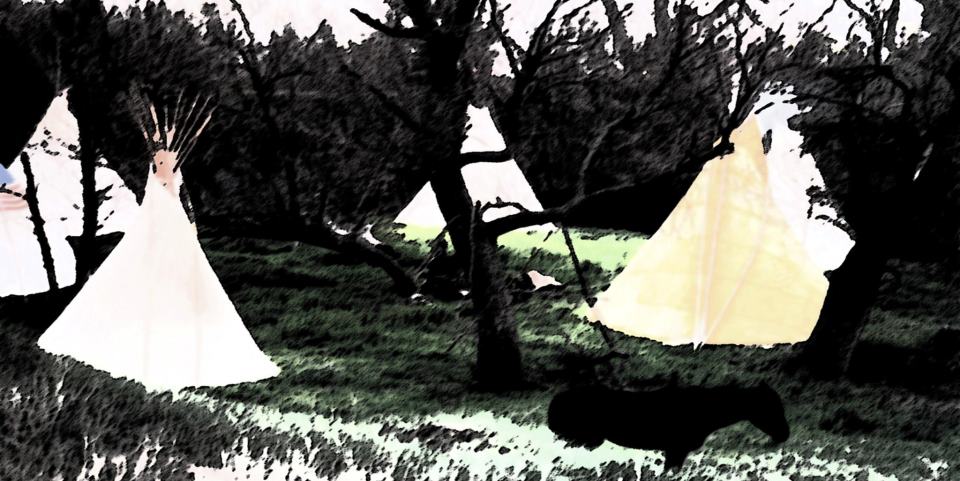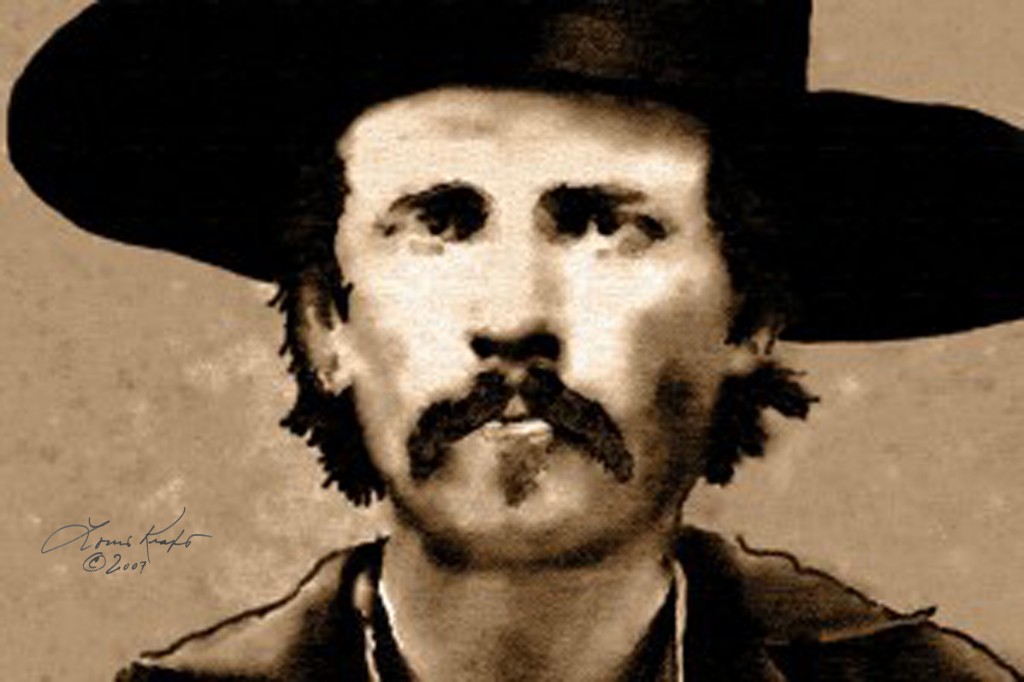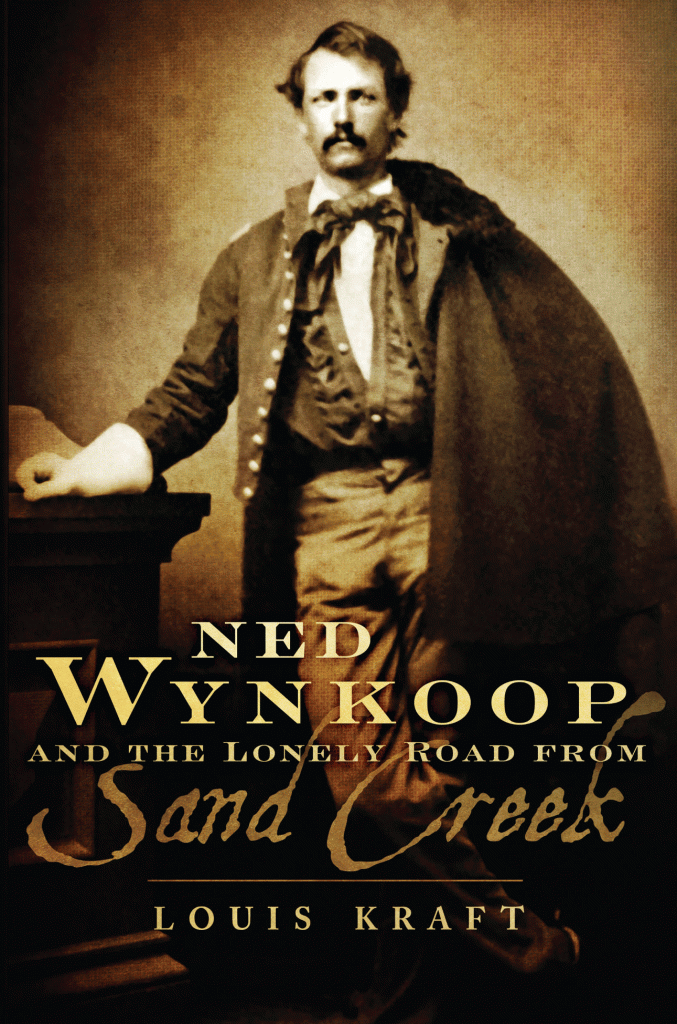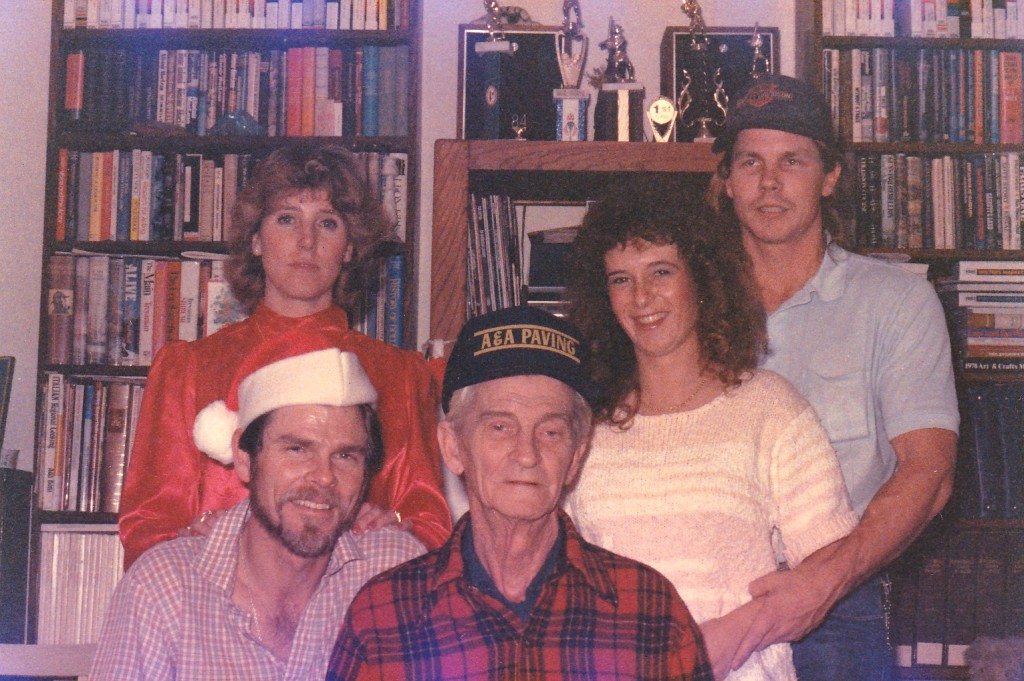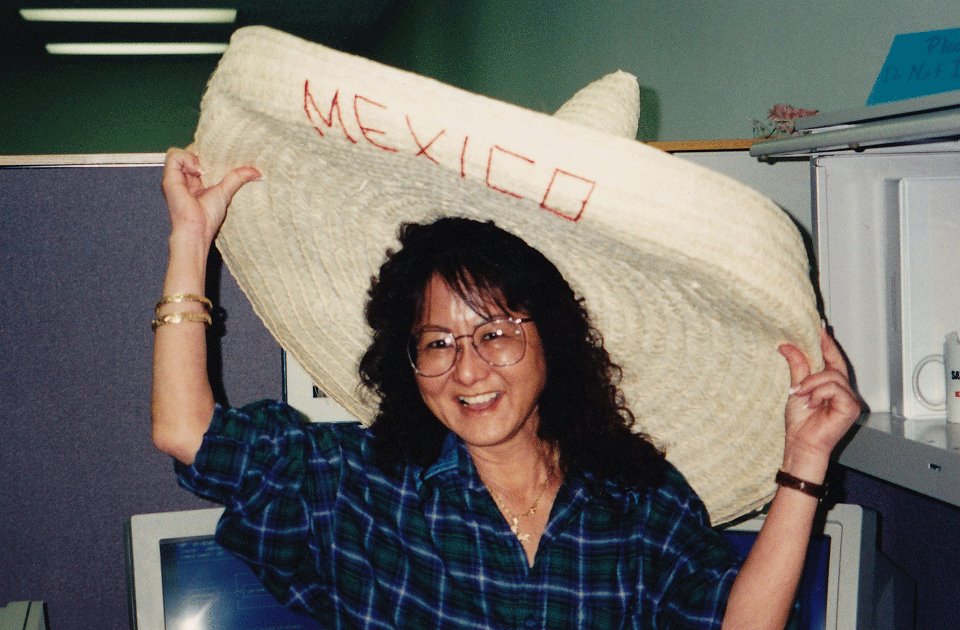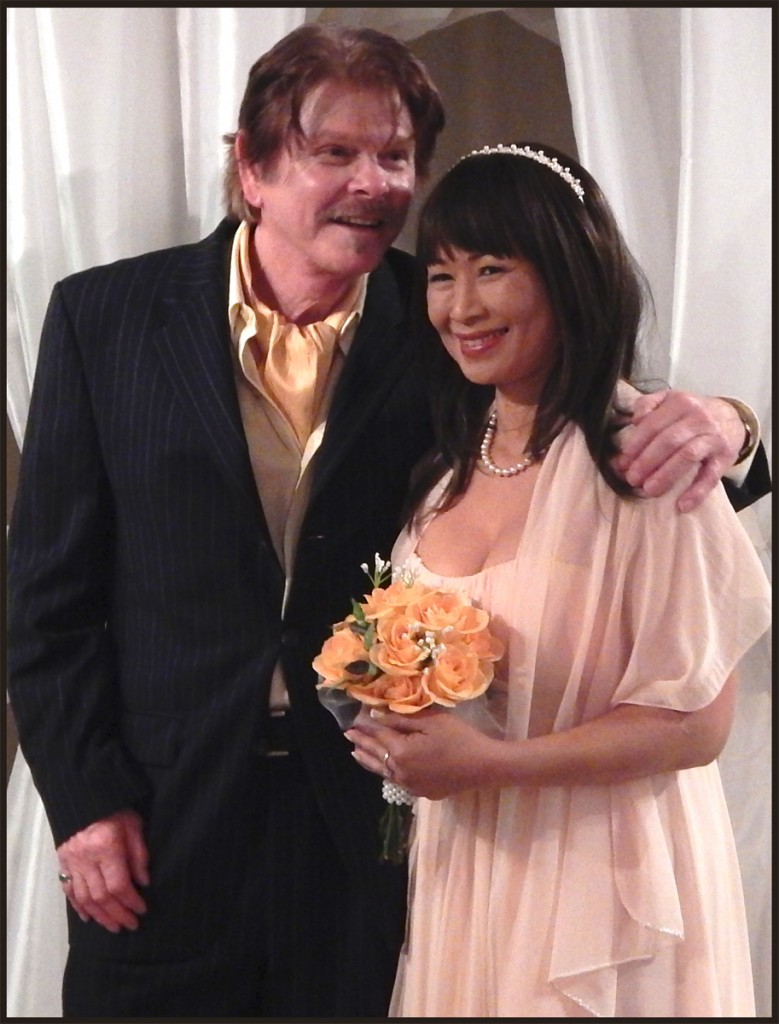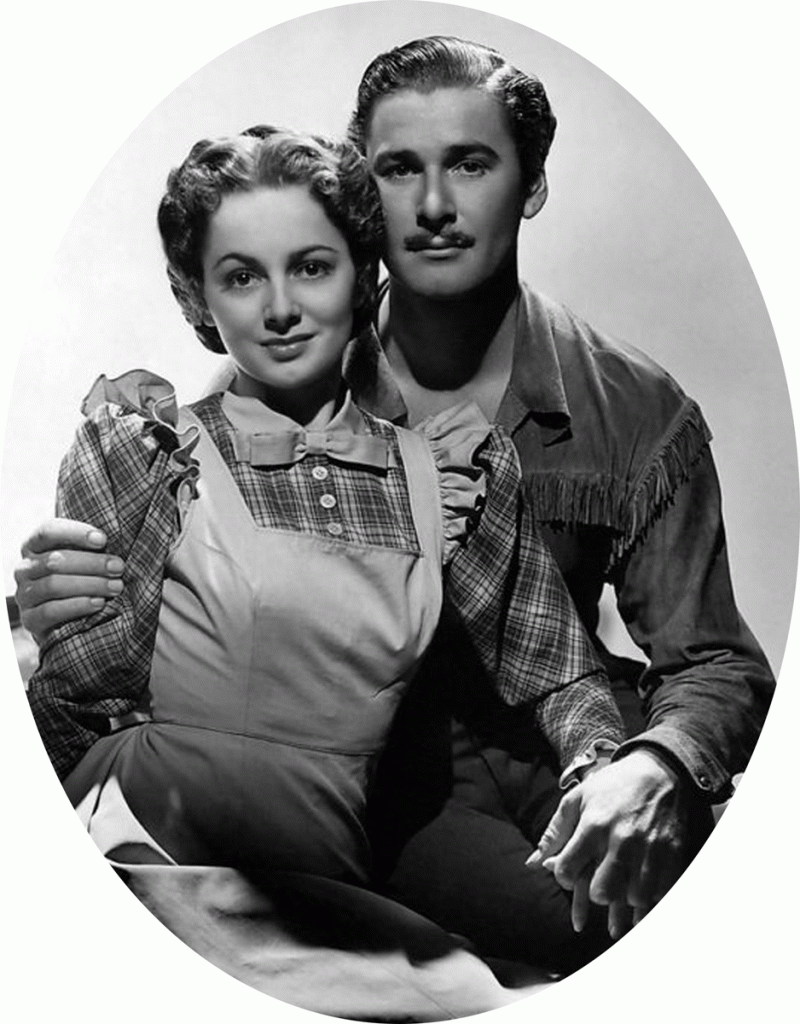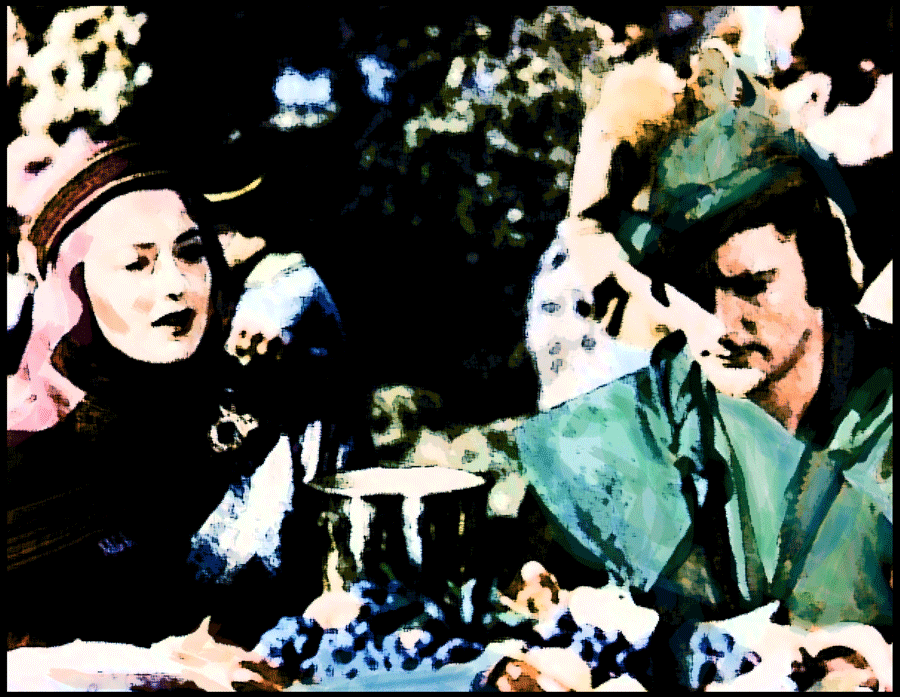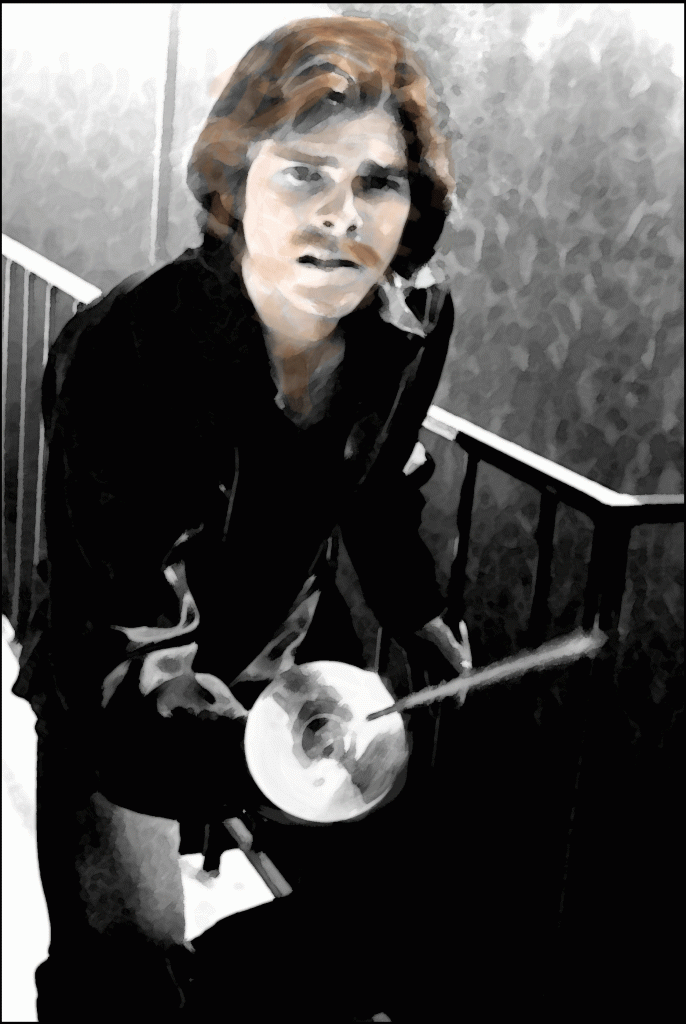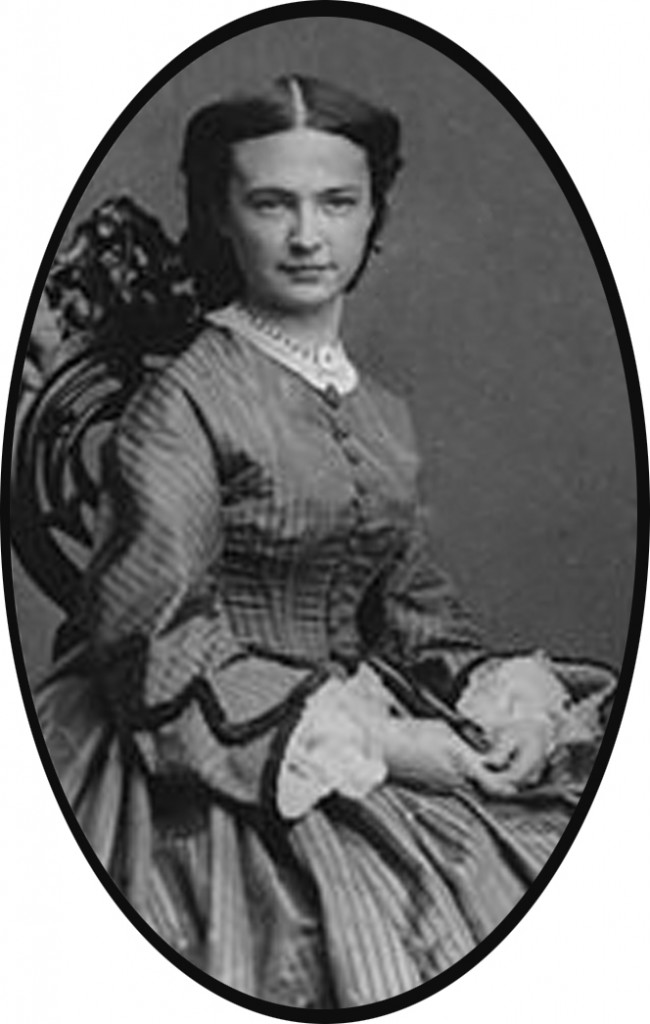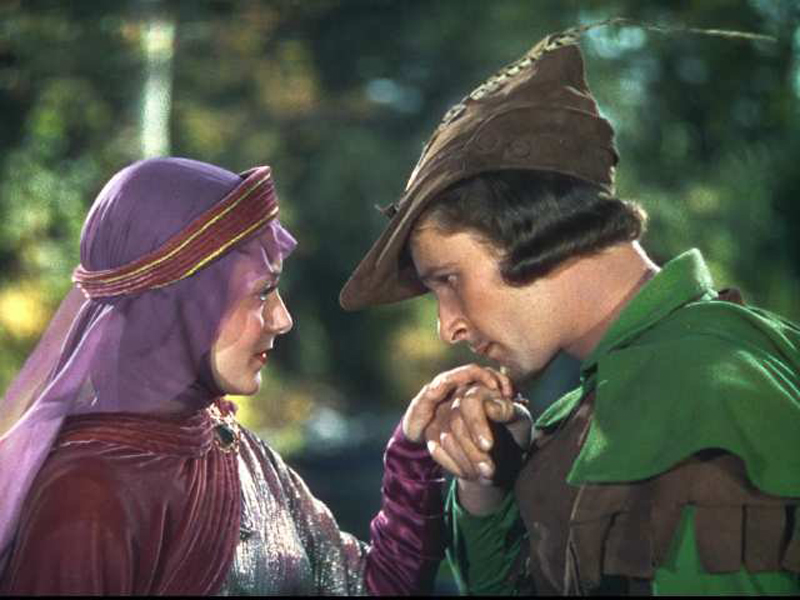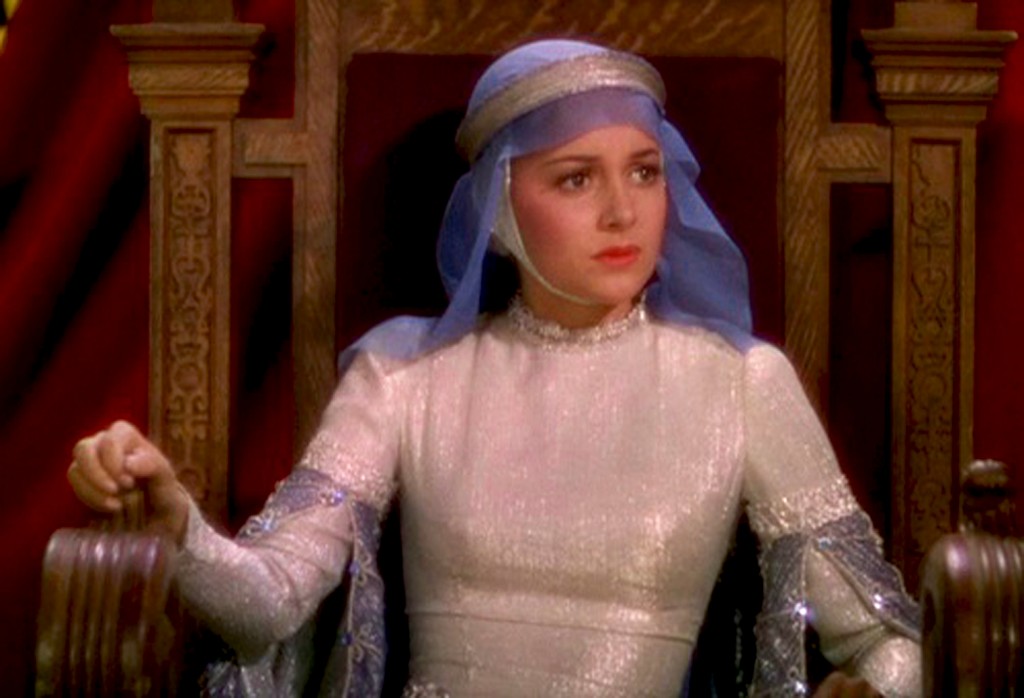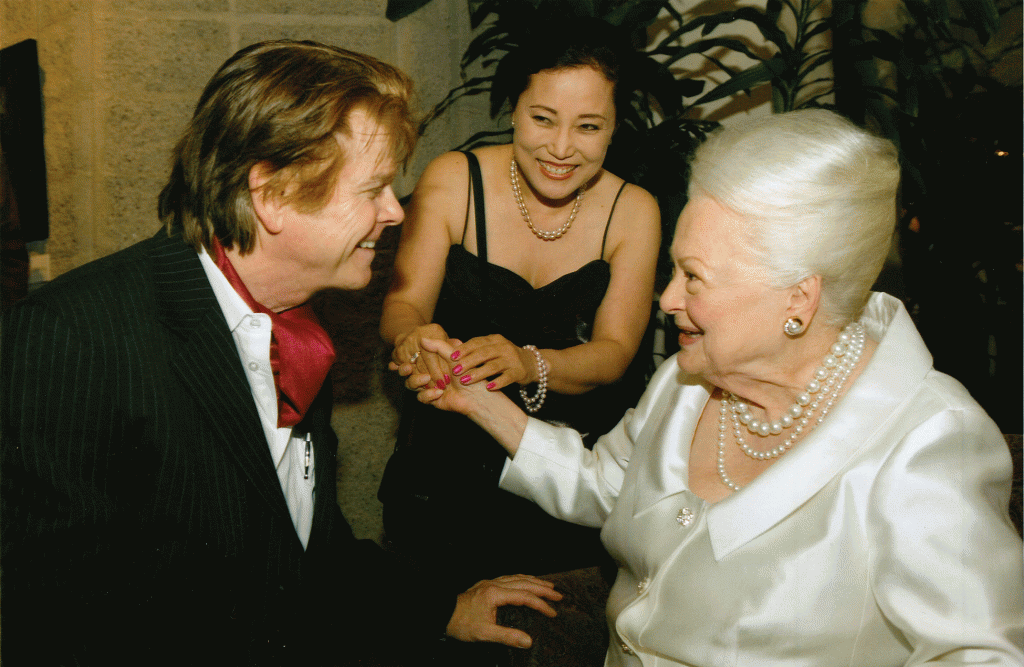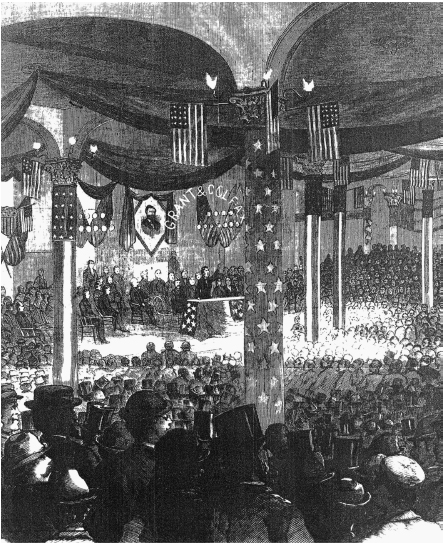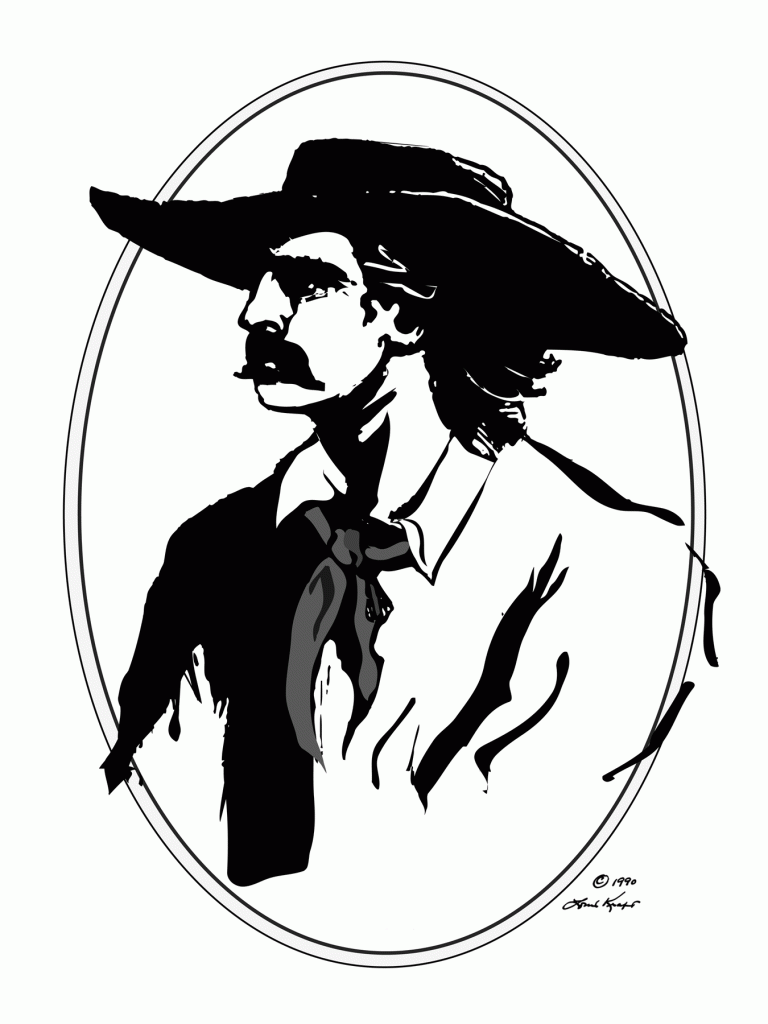Website & blogs © Louis Kraft 2013-2020
Contact Kraft at writerkraft@gmail.com or comment at the end of the blogs
For starters I should state that film has played an important role my life.
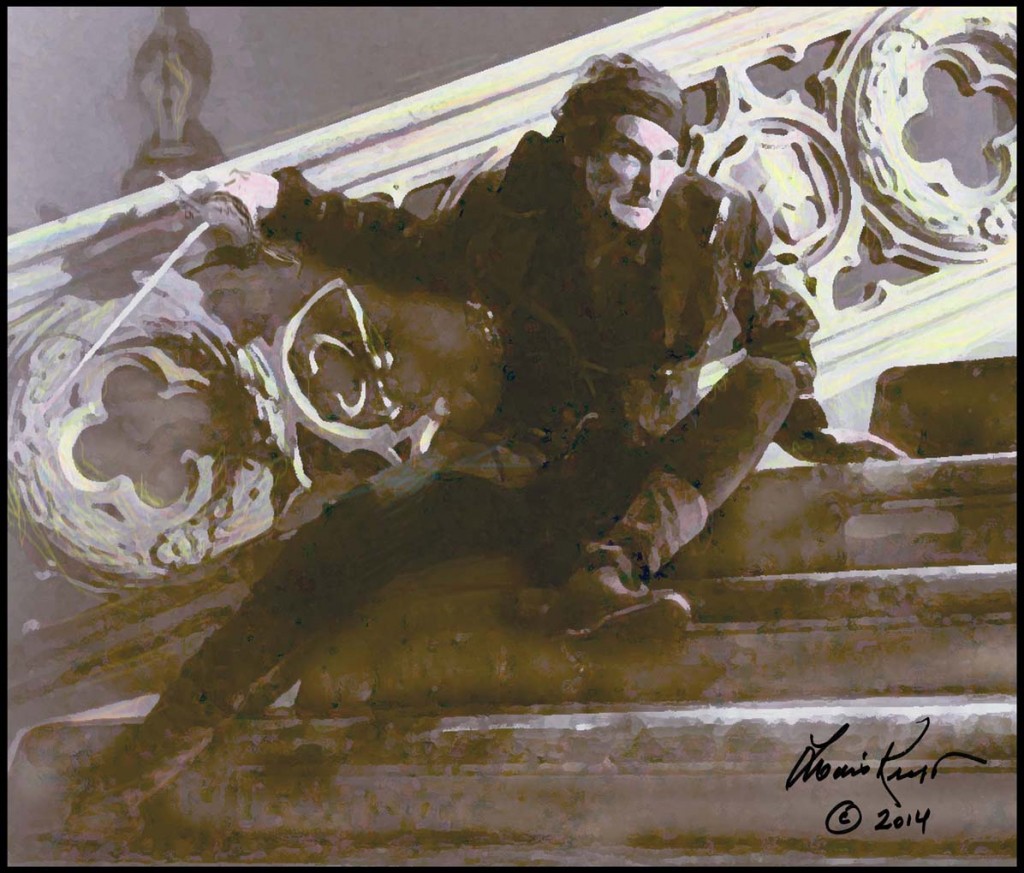
Errol Flynn as Don Juan in the final duel in Adventures of Don Juan (1948). In my opinion Flynn’s sword fight to the death with Robert Douglas as the Duke de Lorca is by far the best duel captured on film. I’ve heard the criticism, such as all the takes had to be short as Flynn was out of breath. You know what? That criticism isn’t valid, for all that counts is what we see in the film. (art © Louis Kraft 2014)
The actor Errol Flynn influenced my life in many ways and for an assortment of reasons. Looking back the most important reason was that he has been the most un-racial person that I have ever studied. In this blog I’m going to talk about my discovery of Flynn and his influence on me while discussing some of his performances on film (and this will include a few comments that will surprise and perhaps shock).
Know that my views don’t jive with popular opinions that have
been oft-repeated by writers and the media that do little original thinking
and buy into what is over and over again stuffed down their throats.
My opinion of reviews and reviewers is not sparkling
Reviews are opinions; some are based on bias while others are based upon sales or what the media has proclaimed and stuffed down our throats. … Also know that many reviewers base their opinions on what they saw on film or read in a book or viewed on a canvas (these reviewers should be praised and not considered brethren to cretins that have an agenda).
Film acting is a lot different than acting on stage. AND it must be natural, and let me tell you that sometimes this is very difficult to do—especially when you’ve got 35, 40, 70 people staring at you and you are now into your tenth closeup take for a scene and the producer is on set bitching about being over budget and screaming at the director why the idiot actor—you—can’t play the scene right.
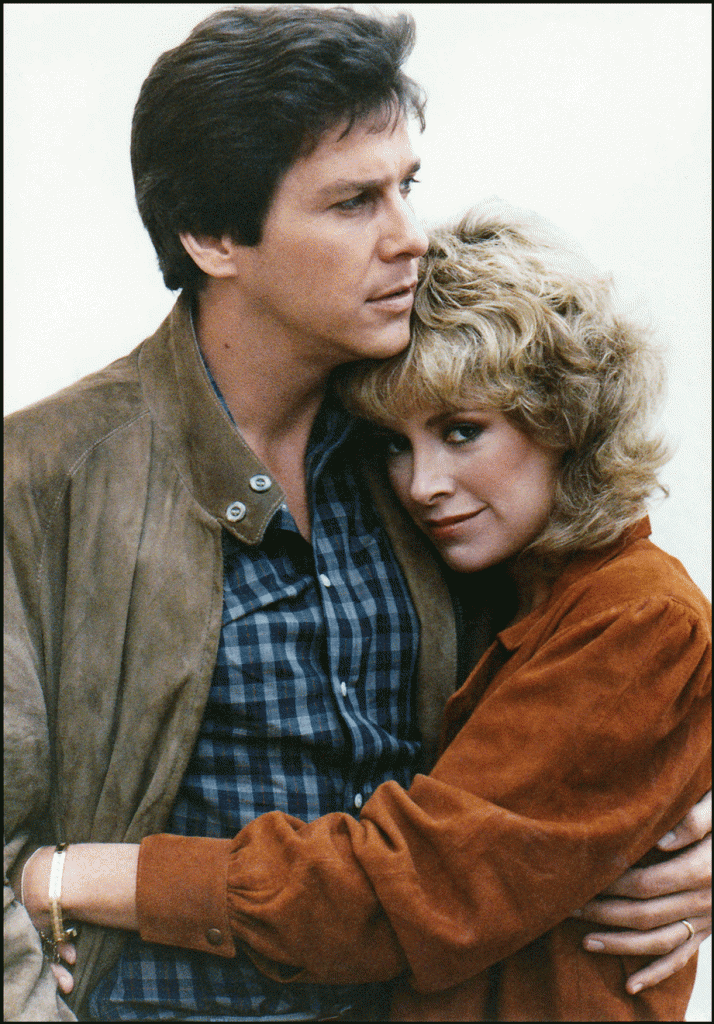
A publicity shot of Tim Matheson and Catherine Hicks from the short-lived TV show, Tucker’s Witch. (LK personal collection)
I saw this happen while working on Tucker’s Witch (1982-1983), which I thought was a decent TV show if it had had a chance to succeed. Already it had been canceled in its first season but the contract stated 12 episodes and we were then shooting episode number 11 or 12. The actor was a TV star with some film hits, charming, natural, and competent but now a producer had pulled the rug out from under him. The actor struggled, and bless him for he kept his composure as much as possible in a situation that should have never happened as he fought to perform as demanded by someone who should have kept his mouth shut and who should have allowed the actor and director do their jobs.
What the hell! Money is privilege and it rules.
As are reviews, valid or not. Believe me, they can make one feel good and they can also make one feel like slime that should be flushed down the toilet.
Money can “win” elections, or should I say “buy” elections? Reviews do more—much more—to individuals as they can hurt and destroy or build up and create. For the record reviews are sometimes biased. By that I mean that they can fry a performer (let’s say Richard Gere) or praise a performer (let’s say Bruce Springsteen) over and over again. When this happens it is based upon the reviewer’s bias. Here I’m talking about a Los Angeles Times film critic that eventually became the Times music critic. He’s not with us anymore. Ain’t that a shame.
The early days & a Tex Ritter influence
Film and I joined hands back when I was somewhere around four or five years old, and this time dates all the way back to Yonkers, New York. I lived with my father, mother, and infant sister in a wooden house that my mother had grown up in (my father and mother had bought it from her parents). Yonkers—at least where we lived—was in the hills and not far from the Hudson River.
 We had a small TV in a large wooden cabinet and the screen was green. I was often glued to Tex Ritter one-hour B-westerns that played all the time (as well as Buck Jones, who I liked; Wild Bill Elliott; Johnny Mack Brown; Gene Autry; Roy Rogers; and many others). Tex was a singing cowboy (as was Jimmy Wakely, Autry, Rogers, and others including John Wayne who made no impact on me for I don’t have any memories of him). Tex rode a white horse (White Flash) and caught bad guys (Autry and Rogers also did this, but often cars were in their films and I found that phony). I guess that it also helped that I liked Tex’s singing (Rogers’ songs were nondescript and Autry’s singing did absolutely nothing for me).
We had a small TV in a large wooden cabinet and the screen was green. I was often glued to Tex Ritter one-hour B-westerns that played all the time (as well as Buck Jones, who I liked; Wild Bill Elliott; Johnny Mack Brown; Gene Autry; Roy Rogers; and many others). Tex was a singing cowboy (as was Jimmy Wakely, Autry, Rogers, and others including John Wayne who made no impact on me for I don’t have any memories of him). Tex rode a white horse (White Flash) and caught bad guys (Autry and Rogers also did this, but often cars were in their films and I found that phony). I guess that it also helped that I liked Tex’s singing (Rogers’ songs were nondescript and Autry’s singing did absolutely nothing for me).
Before long my family migrated to California in a 1950 Hudson Commodore that my father had bought new in ’50. It pulled a 35-foot trailer. My father and mother loved the road and took every opportunity to explore the USA. This trip was no different than earlier trips that they had taken across the United States. It was my second to California for in 1949 my father, mother, and I visited it in a red 1949 Chevrolet convertible. I guess that the Chevy under performed as my father sold it in 1950 to buy the Hudson. He never owned another General Motors vehicle.
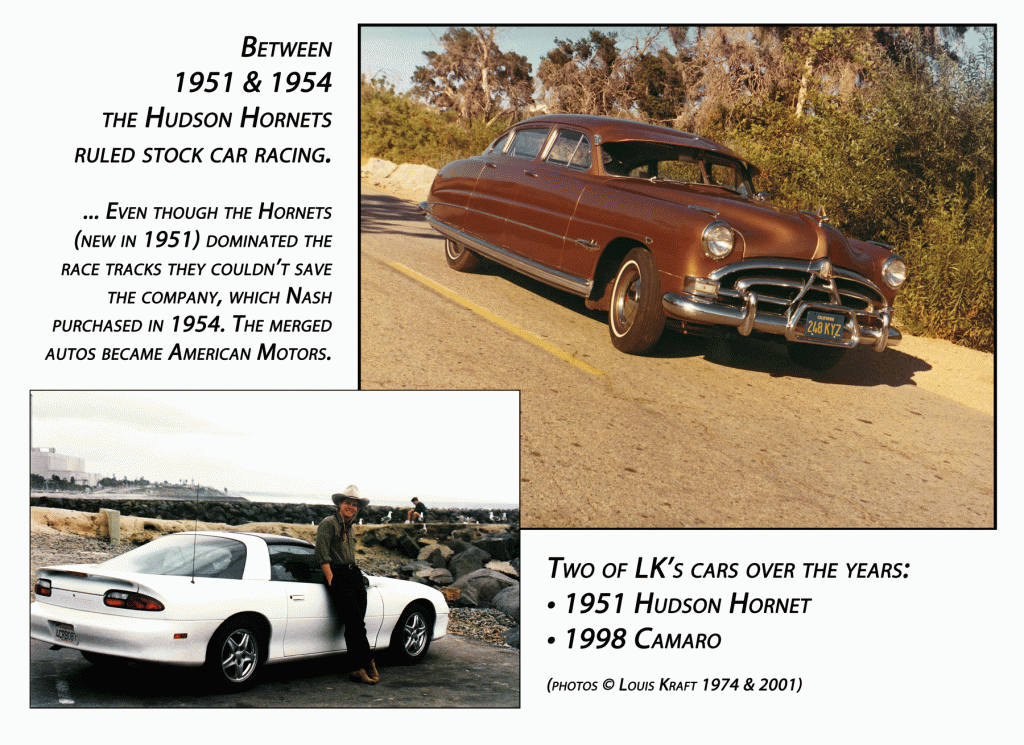
I have a great photo of the Hudson and trailer in the background with my mother, dinky sister, and small me during the exodus to California (but I can’t find it). … Thus this collage. The Hornet was on a rural road in Northridge, California, in 1974. This area is now wall-to-wall houses (a shame). The Camaro was at the beach in northern San Diego County.
When I bought a new Camaro in 1998 my father told me that I’d regret it; I didn’t and the car averaged 24,000 miles per year until I sold it to buy a Vette in 2007. My father, who had been fragile since 1996 or 1997, refused to ride in the Camaro and didn’t live to see the first Vette (if I had been able to get him into the Vette I’m certain that he would have loved it for he liked cars that gripped the road and went fast). … I can’t remember the 1949 trip, but the 1954 trip took perhaps 60 days (there were no freeways, but we weren’t burnin’ rubber as we zig-zagged across the USA). In California we moved around hooking up the trailer in backyards with horses and goats and pigs and chickens and sometimes cattle in the very rural San Fernando Valley (most of which is in the city of Los Angeles and all of it is in the county of Los Angeles) before we settled in a trailer park in Van Nuys.
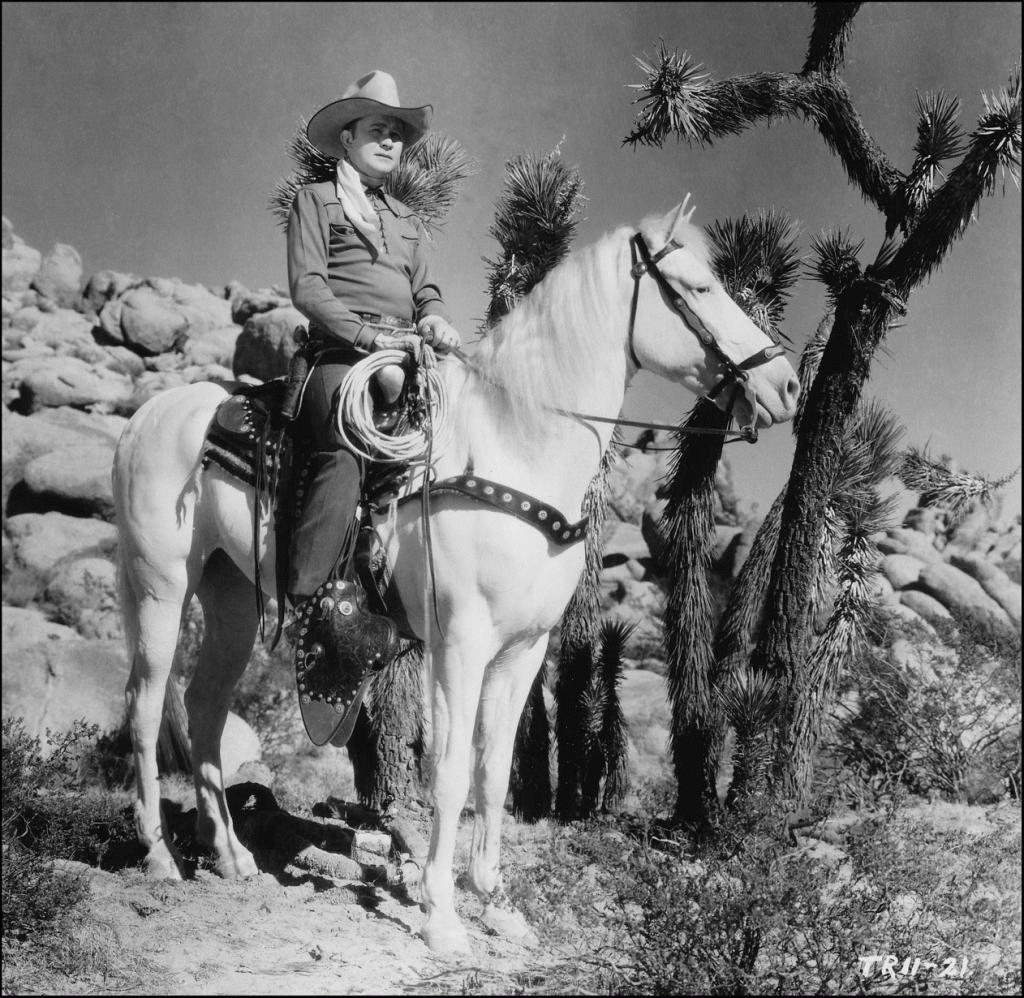
Tex Ritter on White Flash. This image represents the first job description I ever had, that is I wanted to ride a white horse and shoot bad guys like Tex did. (LK personal collection)
About this time my mother asked me what I wanted to do when I grew up. I told her that I wanted to ride a white horse like Tex and shoot bad guys. She shook her head. “Tex is an actor. The bad men he shoots don’t die for they are actors too.” It was at that moment I decided that I wanted to be an actor.
During my early years I attended at least eight elementary schools, and perhaps more (the only two grades wherein I spent two years in the same school were the fifth and sixth grades). Sometime, probably in the fifth grade, I saw my first Errol Flynn film.
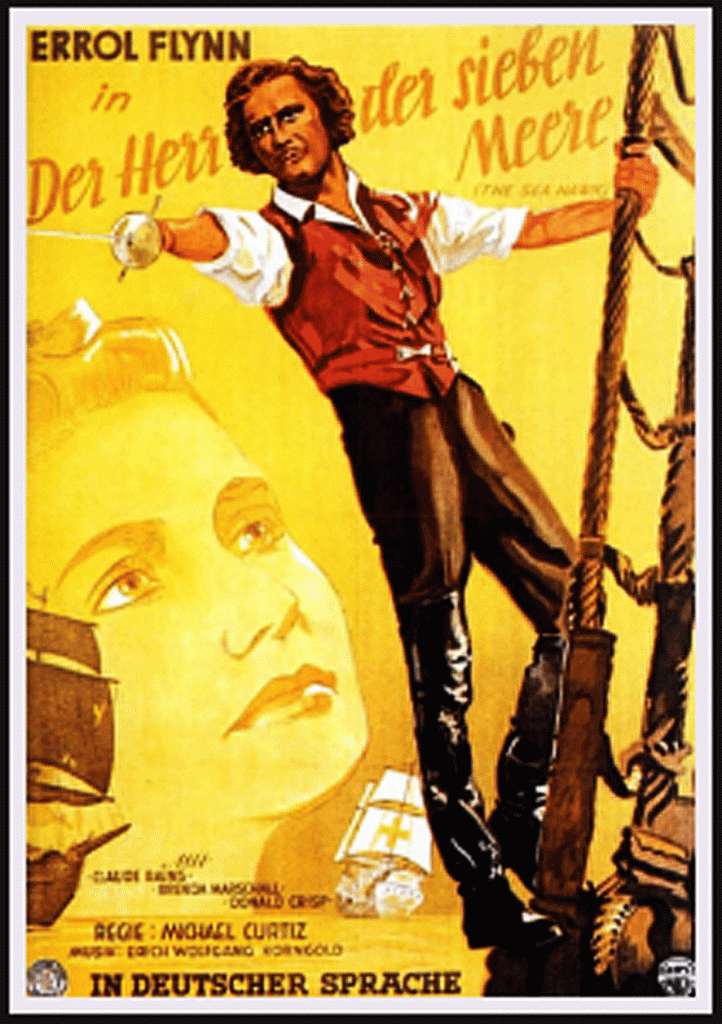
I believe that this is the 1948 German one-sheet for Flynn’s 1940 film The Sea Hawk. I had originally liked this poster, but my view has changed over the years.
It was the 1940 Warner Bros. production of The Sea Hawk. I had already become a gunslinger (actually this had begun in Yonkers). There’s film of this, but my sister took it after our father died. After she died her husband dumped truckloads of stuff in my backyard but the old films from the New York years were not included. I guess that they hit the trashcan as he decided to start his life over and jettison his past. By now I was good with my cap guns. The pirate Flynn added swords to my repertoire (The Sea Hawk would add much more to my life, but that would be decades in the future).
Junior high school gave me three things: Better sports competition (although Dennis Kreiger, who would again meet up with me in high school and then our early college years was the perfect adversary in the fifth and sixth grades), acting classes with performances on stage, and best of all learning to duel with Ralph Faulkner. Faulkner had become the amateur world sabre champion in 1928 and competed as a member the U.S. Olympic fencing squad in 1932. Although he had come to Hollywood to become an actor (and he had silent film credits) his legacy was his long career in film as a stunt double and choreographer of film duels, which had directly led to him opening a fencing academy on Hollywood Boulevard in Hollywood, California. I actually took a third place in a foil competition at his studio while in junior high school, and I competed against adults.
There were no swords in high school, but in college I took fencing in my first year. I became a favorite of Muriel Bower, the coach, and she asked if I wanted to join the fencing team. I said that I would but only if I fought sabre. She agreed and I trained. … But we didn’t see eye-to-eye. You see I was a theater major, and this made my normal school day 7:00 AM until 10:30 PM or later during the week and often this included performances on weekends (backstage and when lucky on stage). This problem would haunt me over my professional life in the entertainment industry when I needed a job to earn extra cash. …. If it had been real life instead of a major 1966 multi-university competition at UCLA in which in real life I could have killed Bobby Crawford (Johnny Crawford’s brother; Johnny was famous for his part as The Rifleman’s son on TV and as the singer of decent pop tunes at the time such as “Cindy’s Birthday” and “Rumors”). I was still learning sabre and I only fought sabre in the competition. I held my own but I didn’t win. There is a running sabre move wherein the attacking duelist runs by his opponent and slashes at his shoulder or head as he passes. I hadn’t learned how to parry it yet (actually Bowers hadn’t even discussed this move with me). In an earlier duel that day an opponent scored a hit when I failed to parry (block) the attack. In my duel with Bobby Crawford, who at that time was one of the best sabre duelists in SoCal, when he began to charge with the cut that I didn’t know how to parry I dropped down to one knee as his sabre was raised to strike. As he launched his slashing attack I thrust with all my might and struck him in the chest. The impact was so great that it bent my sabre blade into an “S-shape.” The contact was forceful and he stumbled backwards four or five feet while his blade nicked me on my thrusting arm. Point Crawford as I hadn’t parried his attack. I was up in an instant and rushed to Crawford to ask if he was all right. He said that he was. He wasn’t, and this I knew for his chest would turn black and blue and he would feel the hit for some time. Hell, my sabre blade was in an “S” shape from the impact and totally unusable. If this had been a real-life sword fight Mr. Crawford would have died on that day.
College gave me actor Jeff Corey and actor-director Robert Ellenstein. They set in motion my quest to eventually earn money as an actor (see below).
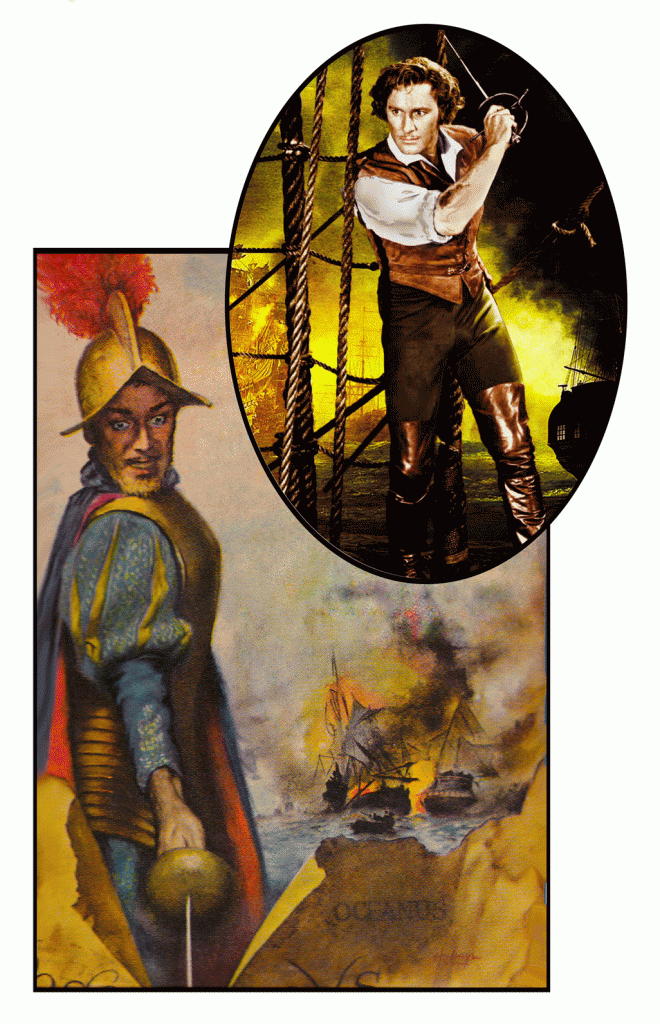
Errol Flynn’s great film, The Sea Hawk (1940), took its title from Rafael Sabatini’s magnificent novel of the same name, which Warner Bros. owned the film rights. But that’s all it took. You see, Sabatini’s novel dealt with an Englishman sold into slavery in Tunis who rises to become a famed Barbary pirate that preys upon English vessels. Sabatini’s story was loosely based upon an Englishman and seaman named John Ward, who was starving at the beginning of the 17th century, and who moved to Tunis and became a pirate lord (the famed Captain John Smith of Virginia fame was the last Englishman to spend time with Ward). … This image is of Flynn as Captain Geoffrey Thorpe, a pirate (BTW the term “privateer” didn’t come into existence until about 1640) who sailed with the blessing of Good Queen Bess (Elizabeth I of England). The other image is my favorite romanticized painting of Sir Francis Drake (I have talked about the Drake connection to The Sea Hawk elsewhere).
Bob Ellenstein would play a major part in my world for five or six years after I graduated college. At times it seemed as if I lived at his house on the Westside of Los Angeles. I studied acting with him and he played perhaps the most important player in my life at that time. We did a lot together, including my introduction to an acting vogue at that time called psycho drama, which probed into an actor’s inner being. Coffee, breakfasts, and lunches at Bob’s home, plus talks, lots of talks, which, believe it not, included the pirate Francis Drake who to this day plays a major role in my research (often I leave him off my upcoming book lists but you should know that he is forever present with me).
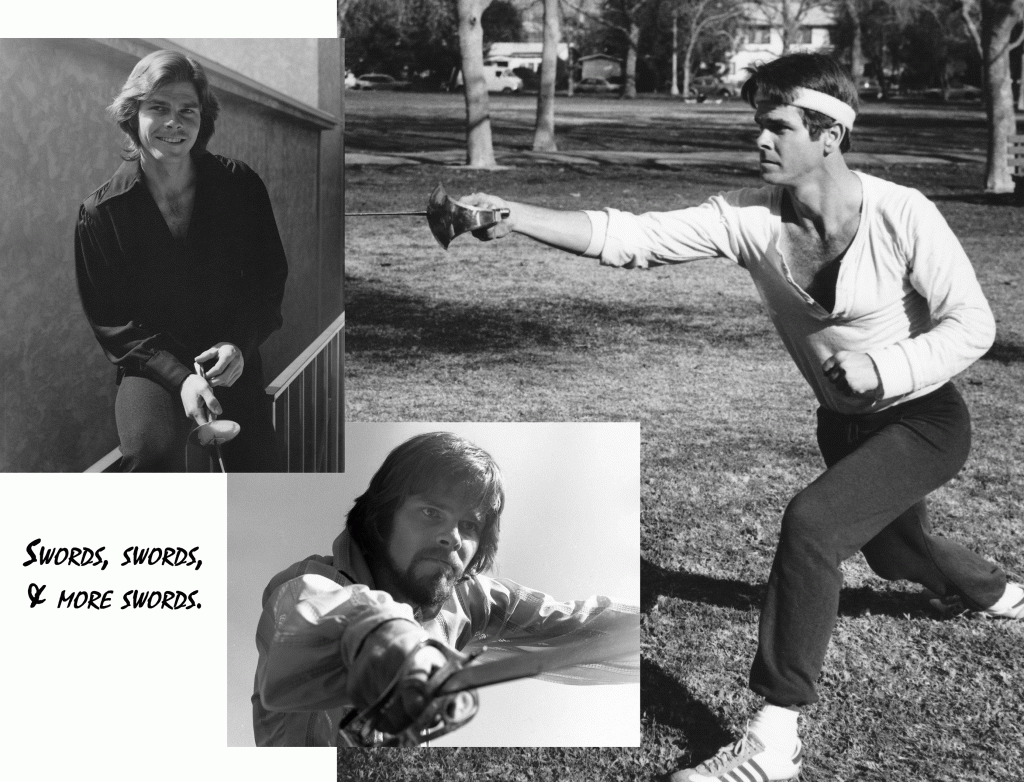
Three images of LK with a blade at different times. I’ve recently discovered other images with swords but they will take time to restore (if ever I decide to spend the time).
Years later I would study stage combat or “swashbuckling” from two people who approached this from different perspectives. This training would lead to me choreographing duels and dueling on stage.
Yes, Errol Flynn impacted my life (but much–much more than you can guess from the above).
Flynn was a natural actor when stage acting ruled film. Most of the so-called “great” actors over-acted and chewed up scenery. Many of these performances simply do not hold up. When viewing film from a time long gone one must consider the life and times of the film industry (just like one must consider the racial and social mores when studying the Indian wars). More important, one must consider and accept (and this is key) the technical world in which films from another era were created.
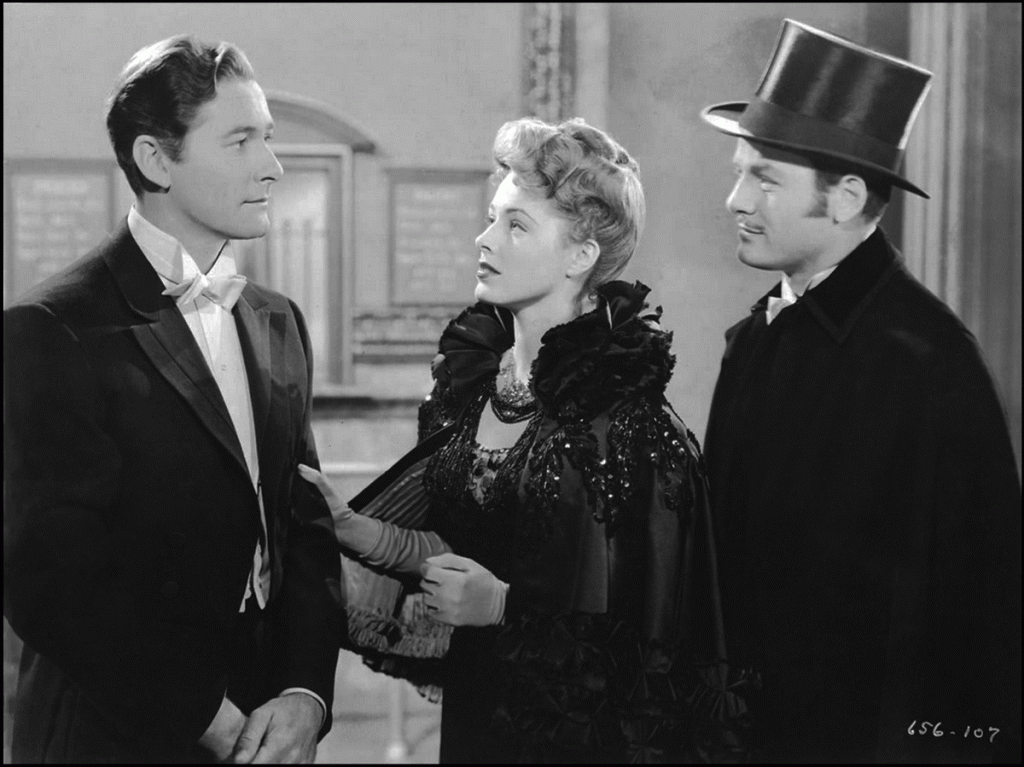
Believe it or not, Flynn’s Escape Me Never (1947) is an outsider film that has the largest chance of making it into the LK top 13 Flynn film list. If this is true it means that the 1930s mega successes for Flynn (Captain Blood, 1935; The Charge of the Light Brigade, 1936; and The Adventures of Robin Hood, 1938) won’t make the list. I know, pure heresy, but with my top Flynn films I’m talking about Mr. Flynn’s performances (and not big bucks). I’ll spend a little more time with Flynn’s Escape Me Never below. Here Flynn is with Eleanor Parker and Gig Young. (LK personal collection)
All this said, good acting survives time (and bad acting doesn’t). In Errol Flynn’s case other life ingredients would play havoc with his life, and because of this his life was extraordinary and worthy of study. Unfortunately long after Flynn’s death writers have written words that cannot be validated because they are out and out lies and this has continued into the twenty-first century. Unscrupulous historians who are little more than mud-slingers that create quotes, print facts that never happened, and often use notes that can never be confirmed because the cited documentation cannot be found. On this last sometimes obscure documentation is used and then totally falsified in the belief that readers won’t have it and if not they won’t make any attempt to find it. … There’s always a “YIKES” to this type of history writing for every so often another historian has the cited and oh-so obscure documentation.
Bullshit is bullshit and lies are lies and fiction is fiction and none of them are valid when writing biography, and trust me for just like my nonfiction Indian wars books I’ll document errors (regardless if they were created on purpose or not). The reason is simple, for these errors should have never seen print and must be corrected.
Damn, that’s a good lead-in to an Errol Flynn blog. Unfortunately my dear friends it isn’t the lead-in to this blog for the following words won’t be accusatory. Actually all I want to do is mention my list of the top 13 Errol Flynn films and three of them are part of the eight that they filmed together. All eight of their films together will be discussed in detail in Errol & Olivia, as well as films that that they didn’t make together.
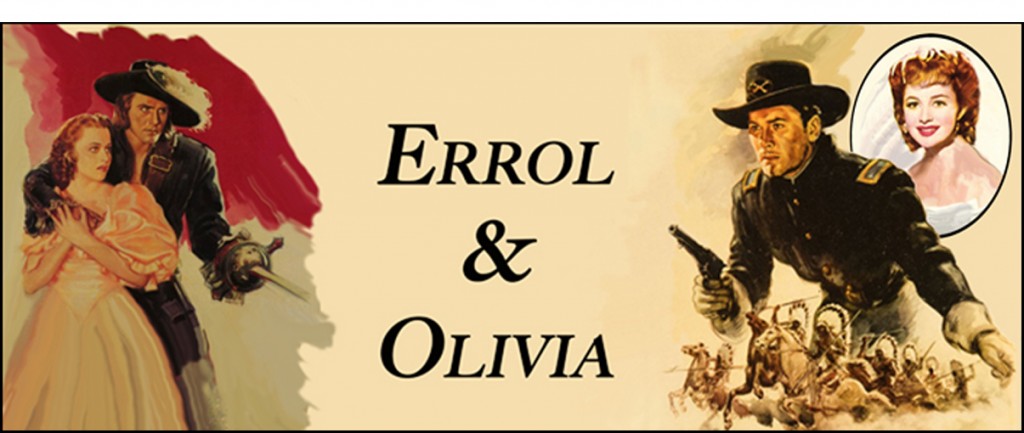 Just so you know Errol & Olivia deals with their life and times and will include additional films over approximately 15 years that they didn’t make together. The book will be a dual-biography and the word count will be at least 135,000, and most likely longer. It will be a biography like none other that I have written in the past and although I have two additional books planned on Flynn they will not be like Errol & Olivia.
Just so you know Errol & Olivia deals with their life and times and will include additional films over approximately 15 years that they didn’t make together. The book will be a dual-biography and the word count will be at least 135,000, and most likely longer. It will be a biography like none other that I have written in the past and although I have two additional books planned on Flynn they will not be like Errol & Olivia.
For the record, and I think that those of you that have an interest in Mr. Flynn or Ms. de Havilland, the following is of great importance. I have a novel that will be published in 2016 (The Discovery) and my work on it is almost complete. I do write about the American Indian wars (my interest is in people that risk their lives to step beyond racial prejudice and attempt to prevent or end war). Sand Creek and the Tragic End of a Lifeway might be the most important book that I ever write. After the Sand Creek manuscript goes into production Errol & Olivia will become my major project until published. This is a major fact and you can take it to the bank.
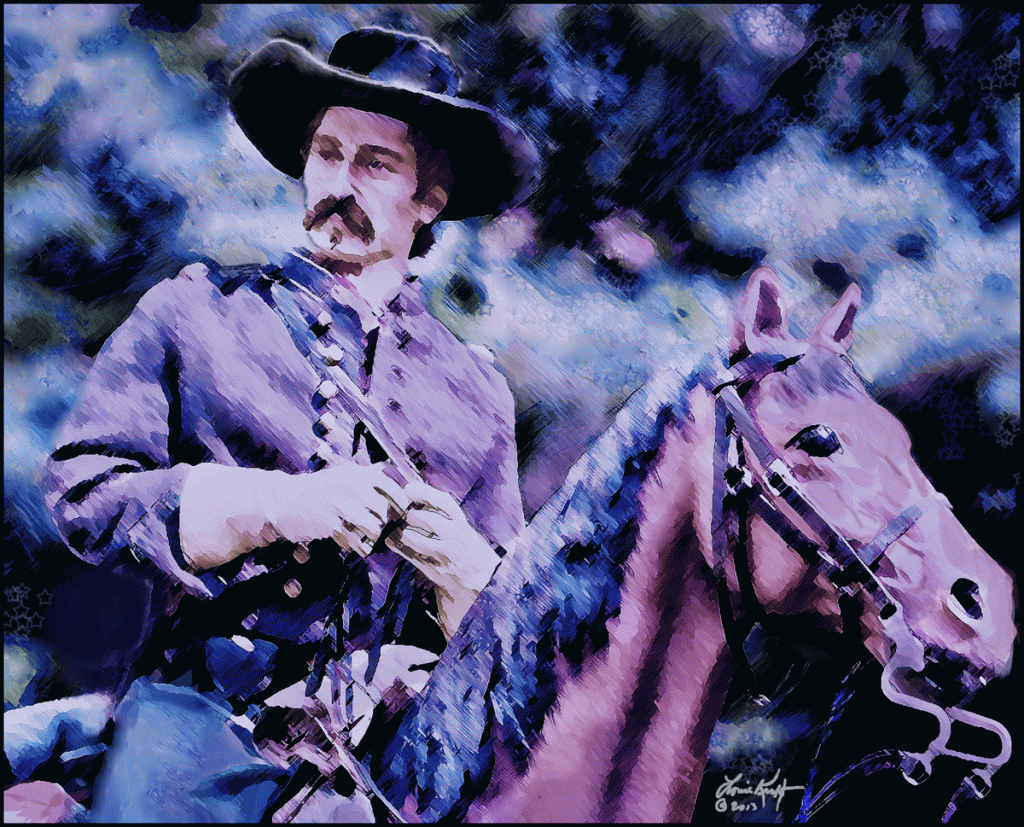
LK art of Ned Wynkoop as he sees the Cheyenne and Arapaho battle line in September 1864. He and his small command faced death but he later that day, with words, convinced the Indians in council that they should secure peace. This rendering of Wynkoop first saw print in the August 2014 Wild West magazine. It may be used in Sand Creek and the Tragic End of a Lifeway. (art © Louis Kraft 2013)
Every person that I write about in biography form was unique and dared to challenge his (or in Ms. de Havilland’s case, her) world. Errol Flynn was unique and he challenged his world again and again. Just like the Indian wars people that I write about, Errol Flynn had ups and downs and because of this he found himself under attack time and again. Like Ned Wynkoop & Black Kettle and Charles Gatewood & Geronimo from the Indian wars, Errol Flynn fought to survive in his world. All of them, including Flynn, stood out, and people from their times and thereafter did whatever was necessary to bury them. There are connecting links, and in Ned Wynkoop and the Lonely Road from Sand Creek I connected Wynkoop to Flynn. And it wasn’t that big of a stretch, and I didn’t need to use the race card. Wynkoop changed from a man who thought that Indians were close to animals. Events in his life changed this view and he dared to fight the press, the military, and the U.S. government to secure a fair deal for the Cheyennes and Arapahos. … Olivia de Havilland fits right into this category, for what she accomplished during her lifetime, and certainly in the 1940s when she dared to risk her film career and challenge Warner Bros. for treating their contracted actors as little more than indentured slaves, she became not just a strong person who dared to challenge a major company that had no qualms with destroying her but a legendary film icon for all time.
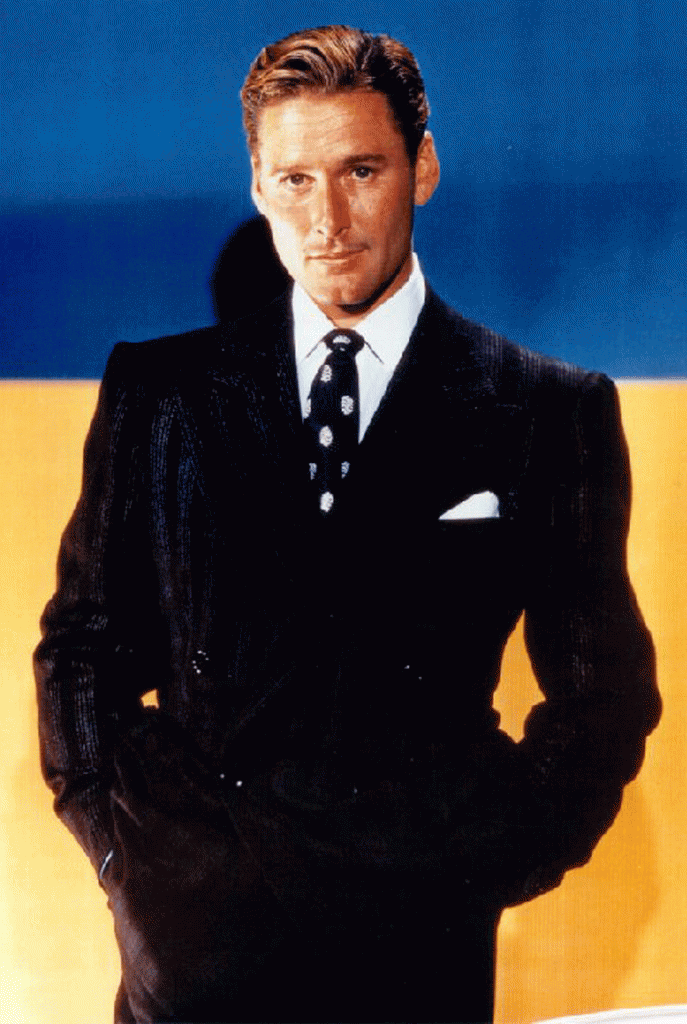
This photo of Flynn dates to 1940-1941, and it is my favorite of him. That said, he probably hated it, for his physical image again and again garnered him less than satisfactory reviews, reviews that either stated he was a “pretty” boy and nothing else or hinted at this. He cared about his work and these criticisms hurt him immensely. (LK personal collection)
Flynn didn’t do this. But just look at his life: He wasn’t in the military and didn’t have to deal with the brutal murders and sexual mutilation of human beings. Why? Simple, for Errol Flynn people were people. As his eldest daughter once said: “He didn’t care what race you were. If he liked you he liked you.” Errol Flynn was the most un-racial person I have known or studied.
Alas, this blog is going to move away from man’s inhumanity to man, away from heinous crimes (and I’m talking about the Indian wars here), and simply talk about Errol Flynn the actor.
LK’s top thirteen Errol Flynn films
This film list has grown. See Louis Kraft’s top 12 Errol Flynn films … a personal view. … The list has been updated.
(top four/alphabetical and firm)
1. Adventures of Don Juan (1948)
2. Gentleman Jim (1942)
3. The Sea Hawk (1940)
4. They Died With Their Boots On (1941)
(bottom six/alphabetical and not firm)
5. Uncertain Glory (1944)
6. The Dawn Patrol (1938)
7. Virginia City (1940)
8. Four’s a Crowd (1938)
9. Objective Burma (1945)
10. Dodge City (1939)
11. Escape Me Never (1947)
12. The Sun Also Rises (1957)
13. That Forsyte Woman (1949)
I won’t be discussing the films on the list or this blog would turn into a book. That said, I will mention a few of the above titles. I’ll also spend a little time with Captain Blood; The Adventures of Robin Hood; Escape Me Never; Crossed Swords; and Too Much, Too Soon; among others.
Not to worry for what I say here won’t give away Errol & Olivia for there is only enough space to deal with a few points—important points—but if they make it into Errol & Olivia they will be expanded upon in directions that you won’t be able to guess from what you read in this blog.
Well-constructed words can always hide bias
As stated above I’m not big on reviews of anything, and even though I just presented you with a list I hate lists. They mean absolutely nothing. I can’t tell you how often I’ve seen lists that have been printed and much of the time I run to the bathroom to vomit. These lists were often created by people that I once considered friends, but turned out to be little more than charlatans. Most of them have egos so large that the wooden boy in Walt Disney’s classic 1940 cartoon, Pinocchio’s nose is minuscule when compared to their regurgitated baloney or worse. Often I see or hear their crap printed or stated ad nauseam (and it doesn’t matter if they merely reprinted what they had heard about films decades long in the ancient past or spouted the virtues of art that is so cliché that it is beyond comment. Did the person who created the list put any effort into creating their list? No! Absolutely not, for the simple reason that their brains no longer function.
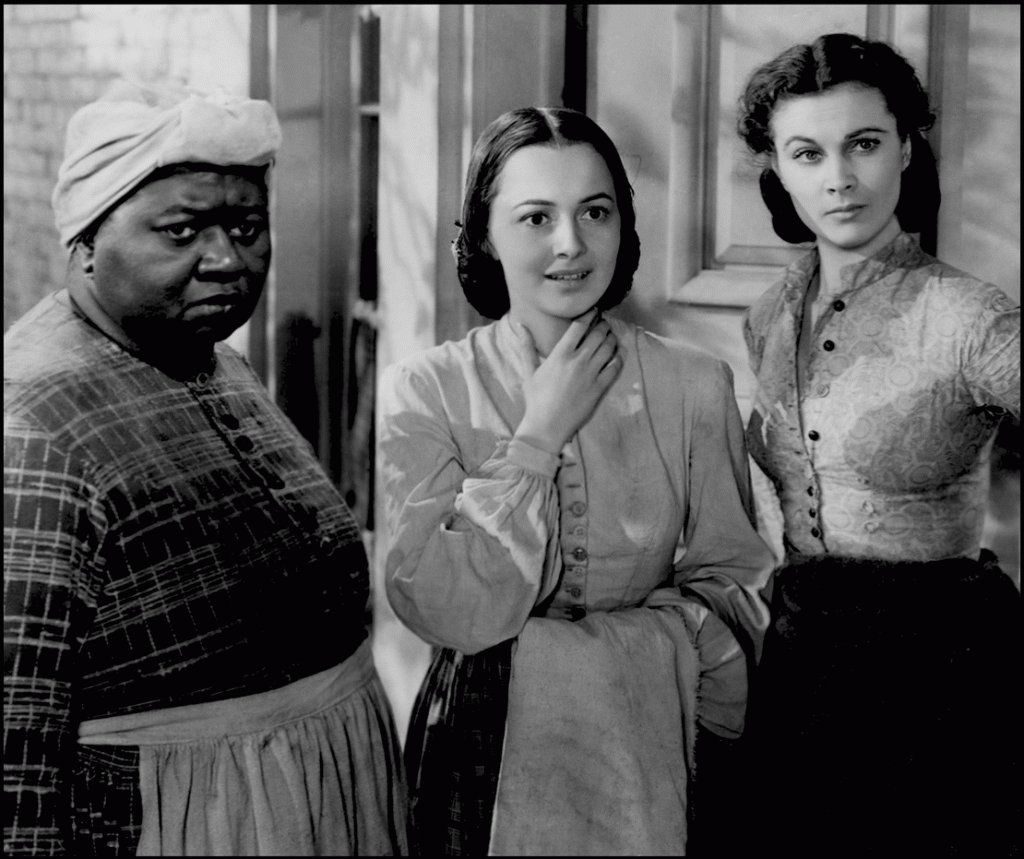
The perfect example of a film that I cannot stomach is Gone with the Wind (1939), a film that Olivia de Havilland risked her entire film career at Warner Bros. to obtain the role of Melanie after she was told that the studio wouldn’t allow her to work in the film. In this image you see Hattie McDaniel as Mammy (left), who deserved her best female supporting Oscar; OdeH as Melanie Hamilton; and Vivien Leigh as Scarlet O’Hara; who Clark Gable as Rhett Butler should have shot in the first reel of the film (of course then there wouldn’t have been a film). My view on this film: I hated it and was bored beyond belief, and even though I own it on DVD (mainly because I wanted the one-hour OdeH interview), I have yet to see this film from start to finish. (LK personal collection)
Of course you know that it’s risky to pick a film that was a huge bust at the box office, and most people who create lists steer clear of films that don’t make a lot of money. Although this isn’t always the case, often best film lists stick with films that were block-busters, Oscar winners, or were so artsy-fartsy that I’ve never been able to get through a complete viewing of them. Read 10 minutes, or if I have time to burn, 15 minutes before I close the boring slop. Goodbye! The plot hasn’t caught my interest and the actors’ performances have scored a zero with me. If the film in question had been a stage performance I would have been screaming “Get the hook!”*
*This is a not-too-kind expression from times past that means slipping a hook that is attached to a pole around a performer’s neck and then yanking them offstage.
I’ve got to care about story and performances. If I don’t, viewing a film is a waste of my time, … and I don’t give a bleep about how great a critic with his thumb stuck somewhere claims the film is or how a certain performance is one for the ages. I can’t tell you how many times I’ve seen Oscar-winning performances in the past and I’ve suffered through the film as I’ve wasted good money to see it in a theater. … While talking about the Academy Awards and other major acting awards I hope you realize that millions upon millions of dollars are spent every year to buy these awards. The awards season that begins late in the year and climaxes with the Oscars in February of the following year has been for years (nay decades) a three-ring circus with often the largest pocketbooks bringing home the bulk of the statues. My view of these TV extravaganzas? A joke. The last time I watched part of one was when I was recovering from a surgery a number of years ago. Glen Williams, my great friend was staying with me, and about two plus hours before the conclusion (and I have no idea what actors or films danced home with the gold that they had purchased) we turned off the television and enjoyed a good Mexican meal at a local restaurant.
| It’s too bad that pro football players, pro basketball players, and major league baseball players can’t spend millions of dollars each year to buy Most Valuable Player awards. Heck, they earn enough in salary and endorsements. This seems like a no-brainer to me. |
The swashbuckler
In 1938 Errol Flynn became connected with Douglas Fairbanks, Sr., when writers began saying that he had donned the swashbuckling armor and boots and followed in the silent film legend’s footsteps. As it turned out Flynn would go on to make nine swashbuckling films. Four of those films would secure his legacy as the swashbuckler for all time. I hate to say this but since Flynn’s death in 1959 no actor has come close to challenging his mark on this genre of film. None.
(For a little more on Flynn and screen dueling see: Errol Flynn, swords, Ned Wynkoop, & of course Kraft opinion.)
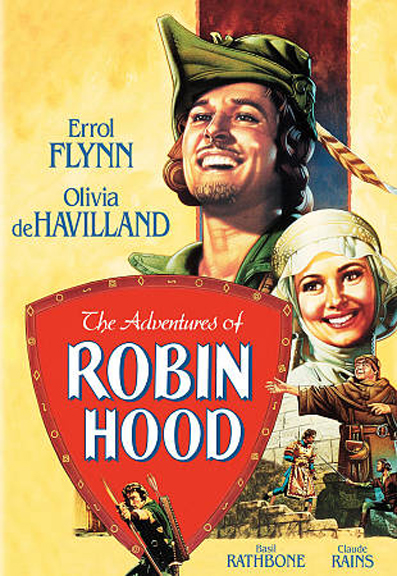
I love this poster of The Adventures of Robin Hood (but I’ve got a poster I like even more framed and on a wall). This poster was created for a video release of the film and I couldn’t believe it when I was lucky enough to obtain a one-sheet of it locally. (LK personal collection)
There are valid reasons why Captain Blood and The Adventures of Robin Hood aren’t on my list of 13 Flynn films, but they are not for this blog. Both films are in the scope of Errol & Olivia and trust me I will spend a lot of time with both them, and a good portion of what I present will be positive. As with my Indian wars books I don’t whitewash the major person or people or their actions. Errol & Olivia will not only focus on Flynn and de Havilland and their life and times but also the eight films that they made together.
Four of Flynn’s swashbucklers are classics: Captain Blood (1935), The Adventures of Robin Hood (1938), The Sea Hawk (1940), and Adventures of Don Juan (1948). In the last three Flynn excelled in the dueling scenes. In one other film, The Prince and the Pauper (1937) Flynn’s duel with an evil captain of the guard (Alan Hale) who intended to kill the prince who was poised to be named king of England as his father (Henry VIII) had died near the end of the film is superb. It clearly demonstrated what was to come.
Unfortunately Flynn’s four swashbucklers in the 1950s don’t compare to his earlier efforts. The most popular reason that I’ve often seen is that Flynn had aged. He had, but he hadn’t lost his grace and skill, … simply his stamina and physical strength. What really impacted his dueling in these films: Against All Flags (1952), The Master of Ballantrae (1953), Crossed Swords (1954), and The Warriors (1955) were the lackluster staging (that is: choreography), film angles, and editing of the duels.
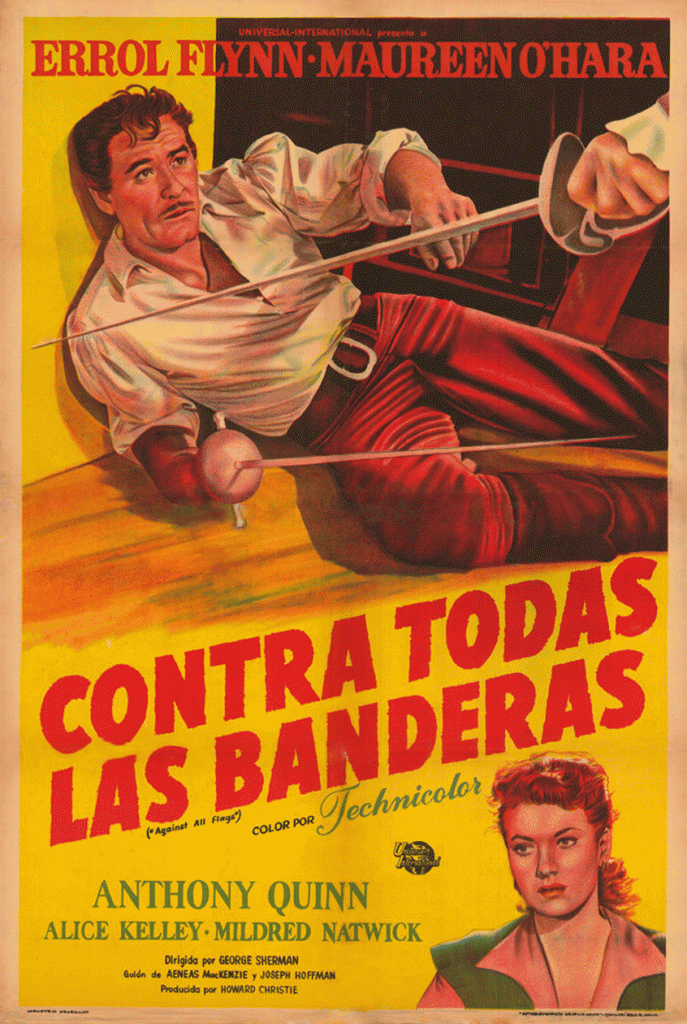
I think that Against All Flags is at the absolute bottom of the nine swashbuckling Flynn films. Don’t doubt that it was a Universal production, which meant low budget. One of the half sheets for the film is absolutely gorgeous. This Spanish one sheet is well-done and I like it. (LK personal collection)
The sword masters that created these duels and rehearsed them with the actors and stunt men couldn’t compare to the great master Fred Cravens (and his crew) that Flynn worked with in the 1930s and 1940s. I have a caveat here. Early in The Master of Ballantrae Flynn duels with his brother (Anthony Steel). This duel is fast-paced and well-done by everyone involved in front and behind the camera (and this includes the editors). By the time that Flynn shot The Warriors his dueling days had passed him by and he said as much in his magnificent memoir My Wicked, Wicked Ways (which is strange for he seemed capable enough in Crossed Swords). By the way, the British title for Flynn’s last swashbuckler, The Dark Avenger, was a much better title than The Warriors. I actually like this film much better than Against All Flags. Alas, Flynn’s duel in a tavern with a French captain (Christopher Lee) was mostly performed by a stunt double. Still the choreography was better than the slap-dash staged fights in Against All Flags, which had the look and feel of a B-film. The best thing about Against All Flags were the one-sheet and half-sheet advertising posters, which were quite good (as opposed to the American posters for The Warriors that did nothing to sell Flynn or the film).
Dancing between reality and a public image
In 1984 I worked on a miniseries called Robert Kennedy and His Times, shown on TV in 1985 (for a little background on it see an earlier blog: How race has affected my life & writing), with Errol’s Flynn’s first daughter, Deidre Flynn. At that time another miniseries was shooting called My Wicked, Wicked Ways: The Legend of Errol Flynn, which was supposedly based upon Flynn’s memoir (which is one of the best books that I have ever read) with Duncan Regehr as Flynn. He sounded like Ronald Coleman, looked nothing like Flynn, and worst of all had absolutely no charisma (he could have been playing Daffy Duck with a British accent).
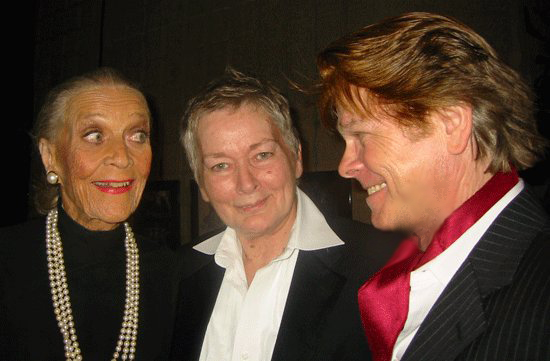
LK connecting with Pat Wymore Flynn on June 6, 2006, when the Academy of Motion Pictures and Arts and Sciences honored Olivia de Havilland (Beverly Hills, California). Deidre Flynn is center in the image. (photo © Louis Kraft 2006)
The production company had asked Deidre to be an advisor for the Flynn miniseries. She had read the screenplay and gave them a resounding response of “No!” She had no clue that I knew a lot about her father (believe it or not my research of him had begun shortly before his death when I was in elementary school). That said, we talked slightly about her dad. She told me that the screenplay was a piece of crap and that she wanted nothing to do with the production. I saw the miniseries when it first aired (and once again a dozen or so years later), and it was a bleeping joke! And I am being kind here. Only two performances were decent—Barbara Hershey as Lili Damita and Hal Linden as Jack Warner (and I’ve never heard Warner’s voice). Everything and everyone else was terrible or worse. If Olivia de Havilland saw Lee Purcell attempt to play her I’m certain that Livvie would have made a couple of runs to the bathroom to vomit. I was embarrassed for her and at that time I never dreamed that sometime in the future I would spend prime time with her. … Enough of talking about a miniseries that should have never been produced.
A few years before the Flynn miniseries aired Charles Higham saw the publication of Errol Flynn: The Untold Story (Doubleday & Company, 1980). I bought it, as I have every book on Flynn that I can get my hands on, and read it. With notations that were so vague they were immediately suspect, Higham would have us believe that Mr. Flynn was both a bisexual and a Nazi spy. The fictional rantings should have been ridiculed; instead they were accepted by the media (which always jumps onto anything that might defame a human being). Oh, and I should mention this: You cannot defame the dead in the United States (at least you couldn’t in the 1980s). Not so in Canada, where the book was also published. If I remember what Deidre told me correctly, she and her sister filed a complaint about Charles Higham in Canada. I don’t believe that he ever dared to reenter Canada again. … Mr. Higham has since moved on to wherever people who fictionalize and distort history go, and I do hope that the flames are sizzling. His travesty of a book single-handedly destroyed Flynn’s reputation and for so doing awarded him massive book sales. Olivia de Havilland called Higham “despicable.” Believe it or not there are other Flynn writers and more than a handful of Western historians that think that there is nothing wrong with what Higham did—rewrite history at the cost of truth and reality. These cretins cite primary source material that is often so obscure that they are certain that no one can find the cited works even if they looked. Guess what: I have research material in every room of my house except for a bathroom and the dining room. Some of these cretins (I should use stronger words here, but I’m trying to keep a civil tongue) cite real documentation (thinking that no one has it or will look for it) with quotations that don’t exist except in their books of lies. When they don’t do this, they misinterpret what the primary source material states (again, always obscure in documentation that is hard to obtain). Their thinking here is that they have cited authentic documentation and it is beyond challenging. … In a word: BULLSHIT!
I’m sorry about the repetition of the above, but this is important.
Facts must always be questioned and confirmed. Alas, this
is so important that I return to it below.
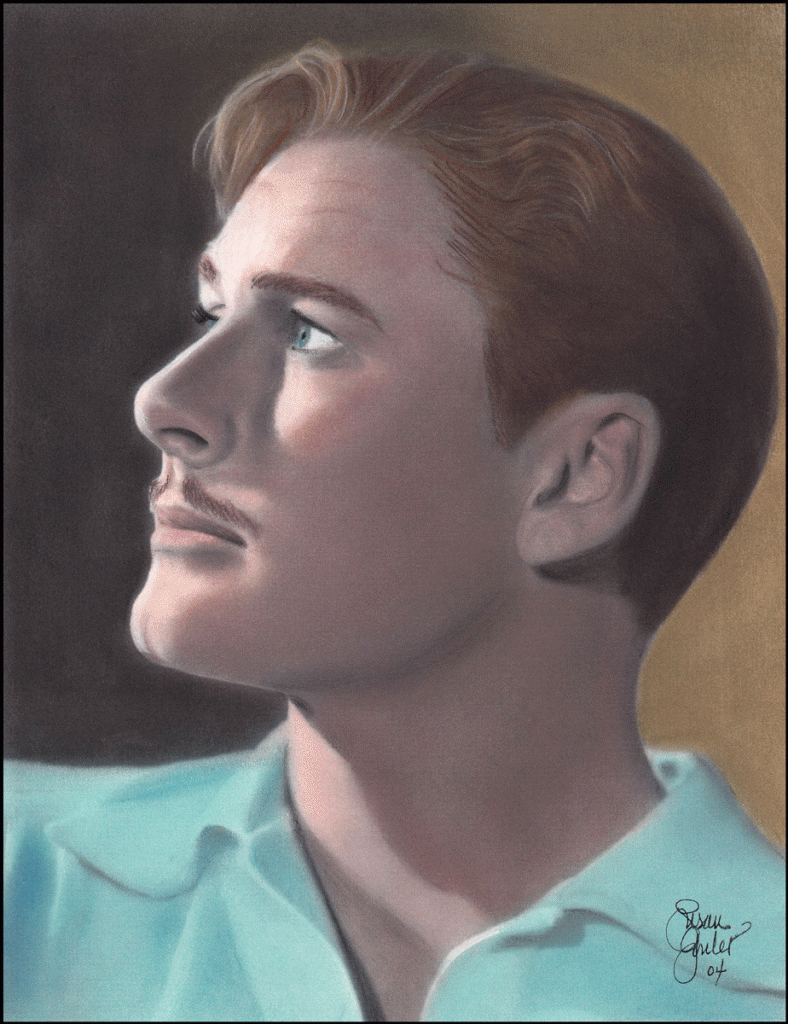
Susan Goulet art of a famed EF publicity photo (© Susan Goulet 2004). I’m not sure if she has the color of his eyes correct. She had created a wonderful portrait of OdeH and I had given Olivia a print of it in 2004 (I kept the original art). She loved it. This image is a copy of the original art in the LK personal collection. Most likely it will eventually end up in the Louis Kraft Collection.
I do know one thing: Mr. Flynn worked hard at being an actor, took an interest during pre-production and production although at times after the farce of a rape trial in 1943 he decided to give the public what they expected of him. This turned out to be a two-headed dragon for not only did he present himself as the lecher that the Los Angeles criminal justice system attempted to paint him as (read: behind closed doors political shenanigans then in vogue) but also that it marked the beginning of a huge downward life spiral that he mistakenly thought he could reverse whenever he wanted.
He couldn’t.
I’m not going to talk about what I see as the real Errol Flynn in this blog (this I’ll save for Errol & Olivia and the two follow-up books on EF). All I’ll say here is that the general population’s view of him as a man, a human being, a father, and as an actor and writer is incorrect.
Over the years Errol Flynn saw his Warner Bros. salary and say in his films grow. By the mid-1940s he had worked into his contracts that he could choose some of his films (his Thompson Productions produced three films) and as his phallic image grew (to his disgust) so did his efforts to break his heroic image. In doing this he easily demonstrated his acting range, but it cost him popularity at the box office.
Finally, and this is related to the above paragraph, Jack Warner would have never invested the amount of money he did over the years in Errol Flynn if he wasn’t sold on Flynn’s creative talents.
Views of a few of Flynn’s films
I’m just going to meander here as I talk about a handful of Errol Flynn’s films that are for the most part not considered among his great films.
Escape Me Never (1947)
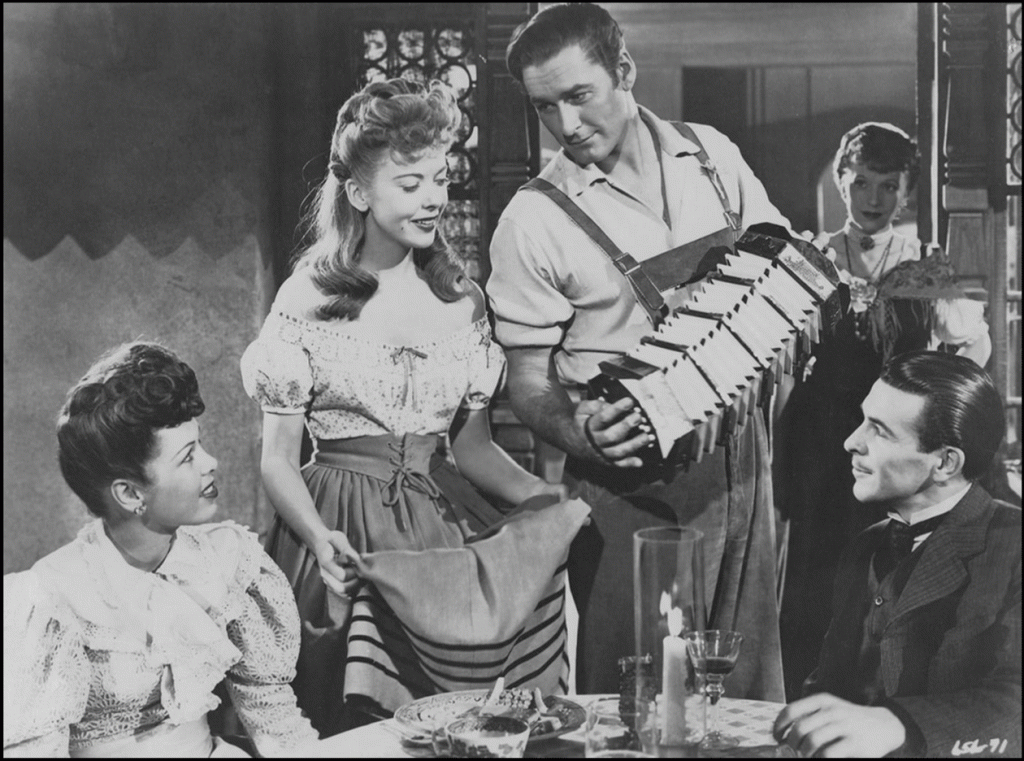
Ida Lupino and Errol Flynn work at hustling for money as they travel across the southern Alps in Escape Me Never. Their off-screen friendship gave their on-screen relationship an extra dimension. Over the years Ida would be one of Flynn’s greatest supporters. He was lucky to count her as a friend. (LK personal collection)
Flynn and his three co-stars (Ida Lupino, Eleanor Parker, and Gig Young) played off each other nicely. … Flynn and Young are composers in Italy. Gig’s lady (Parker) is rich while Flynn’s (Lupino and her infant son) are not. Flynn is a budding genius with an ego to match (which is understandable); he also has a roving eye for the ladies. I hated this film when young and I still hated it when I had last seen it about 30 years ago. Reviewers have always pinged the film on its lack of authentic shots of the canals of Venice as well as the backgrounds of the Alps (and the problem of the phony canals and background images of the alps were obvious the first time I that saw the film when a teenager) but Flynn’s performance was a major discovery for me when I again viewed it this past summer. His acting ability had grown in leaps and bounds in the 1940s and is right on in this film; that is right on in everything except for lecherous glances at women. There are perhaps a handful, and honestly I believe that these were director decisions (like The Adventures of Robin Hood direction discussed below). Looking back it is too bad that Errol and Ida only acted together in this film.
For all of you Peter Blood (Captain Blood), Geoffrey Vickers (The Charge of the Light Brigade), and Robin Hood (The Adventures of Robin Hood) fans I’m going to shock you, so please sit down and hold on tightly. If a Flynn performance and film gets bumped from the bottom six of my favorite EF films most likely it will be by Mr. Flynn and his performance in Escape me Never. I know; heresy. Hey, I’m a former actor, a resurrected actor, and if lucky I’ll again be an actor. I’ve already stated what goes into making a film that grabs my interest. I need to state here that I’m talking about Errol Flynn the actor. I’m proud to say (other than the few director-pushed instances of over acting while eyeing a pretty woman) that EF’s internal system was functioning and his natural instincts were right on target. Perhaps working with people he liked helped, but for my money he was a hundred-fold better actor in the 1940s than he was in the 1930s.
That Forsyte Woman (1949)
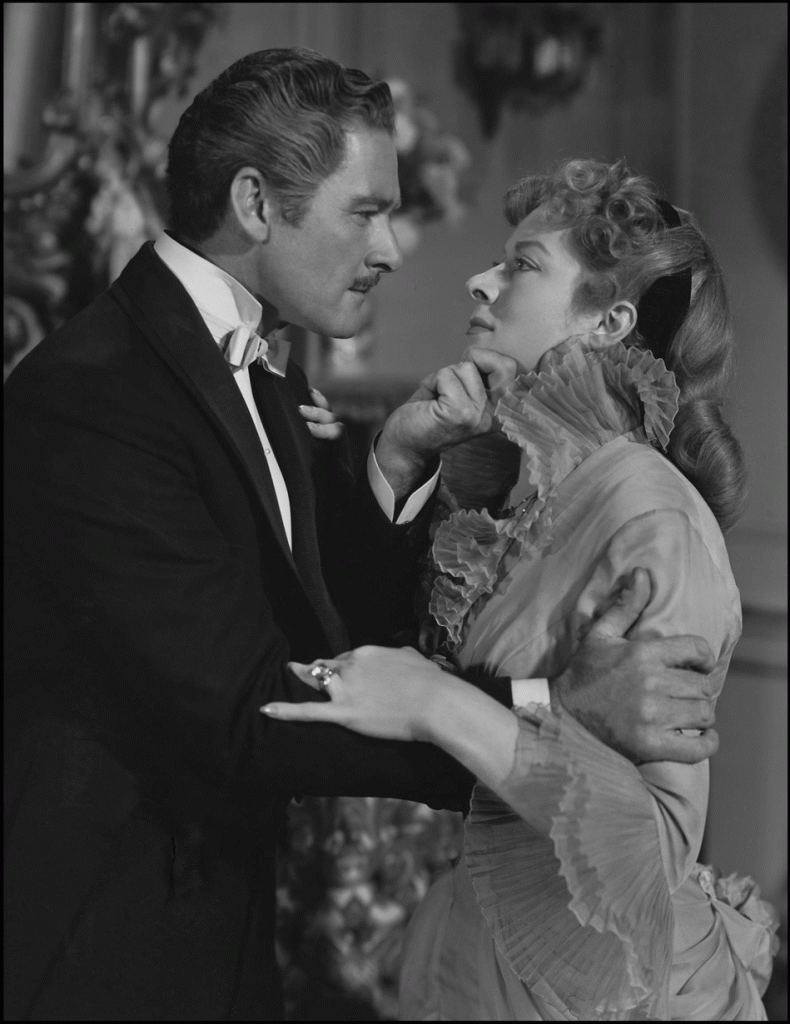
Errol Flynn and Greer Garson in a scene that is hard to watch in That Forsyte Woman. (LK personal collection)
This film was the first under another Flynn contract that allowed him to act in one film per year filmed at a studio other than Warner Bros. This stiff Victorian drama carried Flynn’s performances in Cry Wolf (1947) and the western Silver River (1948) to the next step of being as far away from the adventurous hero as he could possibly get. His performance was controlled and right in tune with the time period. Those who saw the film and expected to see Errol Flynn the hero must have been shocked by the time they exited the theater in 1949. That said, Flynn’s performance shows without a doubt that he really was a magnificent actor. If we can believe his words, and I do, this was one of his favorite performances (if memory serves me, Gentleman Jim Corbett, see the film list above, was another of his favorite roles). Greer Garson, Flynn’s co-star in the film, had heard a lot of trash talk about him prior to filming. After working with him she had nothing but praise for the actor and man.
Ladies and gentlemen, Errol Flynn had taken what he had learned during the 1930s, had crafted during the 1940s, and at the end of that decade put it all together. Regardless of what you think Flynn’s Soames Forsyte, it was perhaps the performance of his entire cinema career. I need to have a top 13 Flynn film list, and this film is on my list.
Here’s a quick thought for you
In 1940 Errol Flynn earned about eight times what
Olivia de Havilland earned. Why? They both became
stars when Captain Blood premiered in December 1935
but the level of stardom was evident by the end of the last
reel on that historic New York City night. … I can’t give
away Errol & Olivia but put the above sentences
together and you should be able to figure
out what happened as both of them
moved forward with their
professional careers.
Crossed Swords (1954)
This is the film that could have been if it had only been a Warner Bros. production. It had the great cinematographer Jack Cardiff (who had shot The Master of Ballantrae, which had been released the previous year, and who would be Flynn’s choice to shoot and direct his ill-fated William Tell). Flynn looked great (and much better than he did in Against All Flags, 1952, and The Master of Ballantrae) and his physical prowess hadn’t deteriorated (actually it looked better than in the two earlier swashbucklers) to what it would be in The Warriors (1955). Perhaps the Flynn-Barry Mahon teaming with an Italian production company was responsible for the result, which could have been much better. Worse, the production team couldn’t provide a decent script, a decent director, complete scenes (many could have used extra cuts and angles added to improve the final product), better action (some is quite poor) or decent actors (I’m not certain of what I think of Flynn and Gina Lollobrigida’s on-screen relationship other than it is definitely better than previously reported. … Alas, some of the acting other than Gina and EF is amateurish).
My DVD was created using an Italian print of the film (Il Maestro Don Giovanni, which would translate to Master Don Juan, leading one to wonder who Flynn played in the Italian release of the film). The color is decent and not faded but not great. The entire film has had an English-language sound track added to an original Italian release print for the DVD. I’m certain that most, if not all, of the Italian actors were dubbed, but the sound (dialogue, sound effects, and film score) is not good. It is obvious that the editors attempted to get the words as close as possible to the actors’ mouth movements, but this meant that now Flynn’s words are slightly off, and it is definitely his voice. My guess is that the complete track was pulled from an English-language release.
For the most part Flynn (as Renzo), who was decent in the film, doesn’t seem to connect with the rest of the cast. My guess—and that’s all it is—was the language barrier while shooting the film, especially for the Italian-speaking actors connecting with Flynn. Cardiff and others behind the camera spoke English but I think that Flynn was the only actor saying his lines in English. Honestly, Flynn was a professional and I don’t think he had any problems with language during the filming.
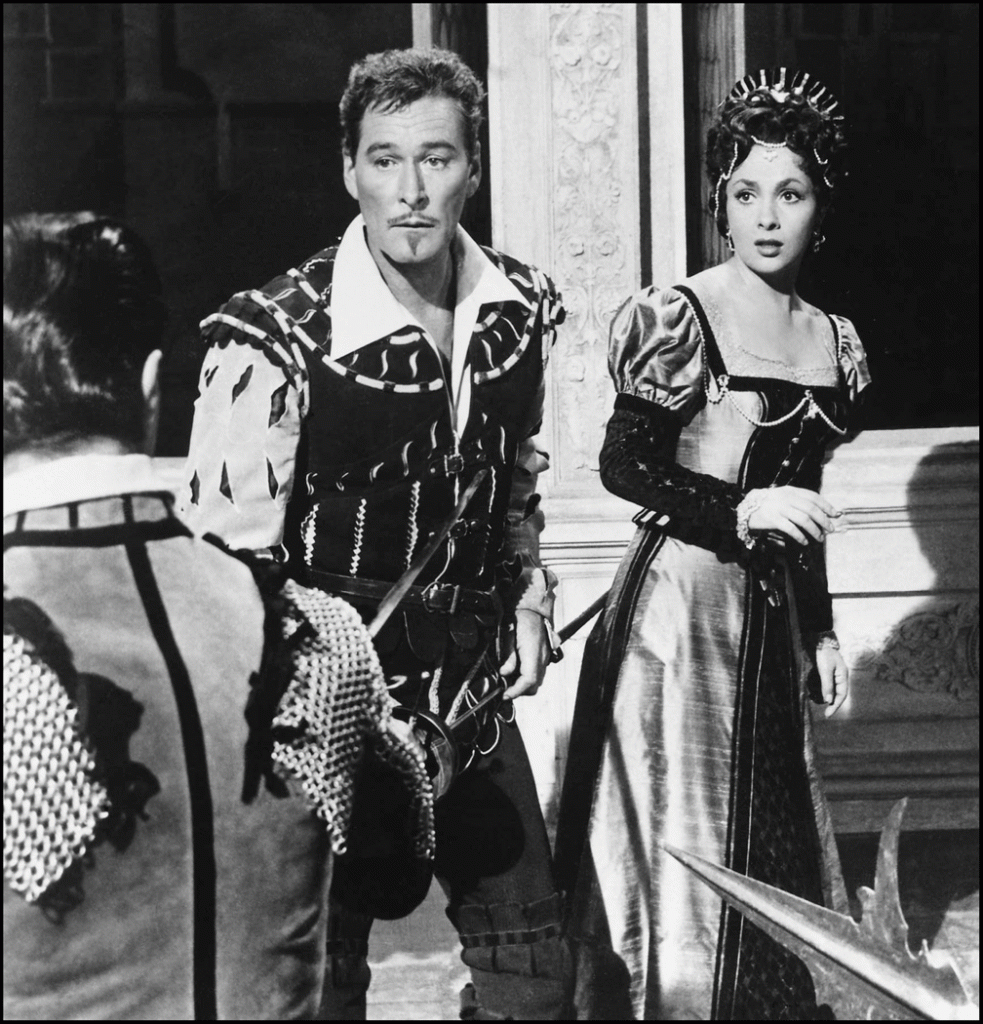
Errol Flynn and Gina Lollobrigida are about to surrender to their fates (as is her father, who is in the scene but off camera in this still). This image shows Flynn’s typical involvement in a scene as well as his physical appearance. (LK personal collection)
Cesare Danova, who played Raniero, Flynn’s staunch friend in their misadventures with the fairer sex, immigrated to the U.S. in the mid-1950s to play the title character in Don Giovanni (AKA Don Juan), which was released in 1955. He would go on to have a long career in American film and TV. My memory doesn’t shout out that he was dubbed in his American performances, but I could be wrong early in his U.S. films. Lollobrigida also began appearing in big American films in the 1950s. … The duel at the end of Crossed Swords was by far Flynn’s best climatic fight against the villain in all of his 1950s swashbucklers. And this is a massive understatement by LK. Flynn performed most of the final duel and his movements were fluid and well-done. His sword work was good and damn-near great (and there was very little stunt-doubling of Flynn in the final duel). Flynn’s swordplay far out-shined everything else he did in the 1950s. The only sword work that compares with his work in Crossed Swords was his short duel with Anthony Steel at the beginning of The Master of Ballantrae.
Again, this is the film that could have been if it had only been a Warner Bros. production.
BTW, swashbucklers co-produced in Europe with leading
English-speaking actors were often less than satisfactory well into the l960s.
Three more EF films and a return to Mr. Ellenstein
Errol Flynn made three films in which two were released in 1957 (The Big Boodle, The Sun Also Rises) and one in 1958 (Too Much, Too Soon). These films, all of which were American-produced after his long self-imposed exile in Europe. They contain, in my humble opinion, his best acting in the 1950s. This Errol Flynn was no longer the romantic hero who wins regardless if he lives or dies by the last reel of the film. Instead these performances were by a man who had lived life and had sunken to the depths of despair and yet had survived. These films presented a man who could no longer swing a blade or ride a horse and knows it as he nears the end of life. They are alive with sadness for an audience that knew what came before and yet they show a man who, if not quite a fighter to the end he does what he can to present as good an image as possible considering his situation.
Only Flynn’s Ned Sherwood in The Big Boodle is active and puts up a fight as he struggles to stay alive while clearing his name of a crime he didn’t commit.
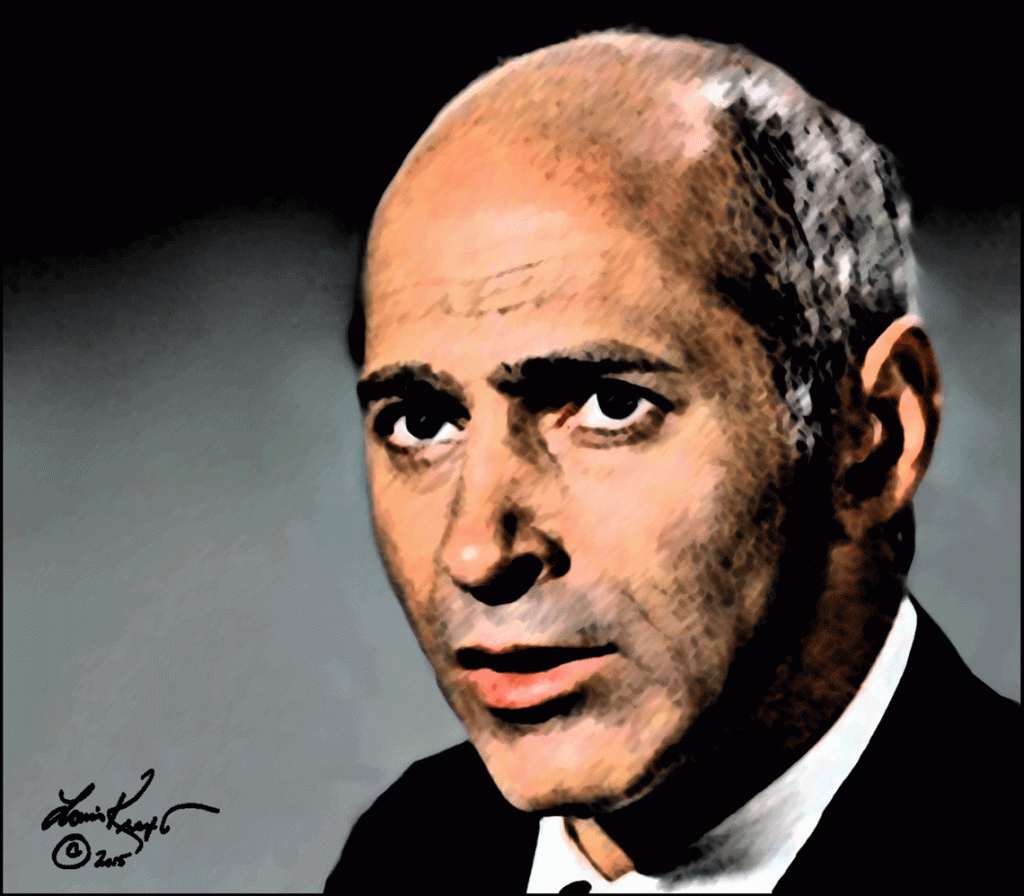
This image is based upon a b&w image in the LK Collection. Robert Ellenstein was one of the most important people in my life. See Bob’s comment about the acting and film world (below), as it gave my life focus at every step. I’m certain that he followed his simple rule as he lived his life and career. … I’ve known a lot of people who were not as they presented themselves. They had agendas that perhaps could be labeled as “heinous.” If yes, these people, if still alive, should be in prison. Bob Ellenstein was not one of these people. He was an extraordinary human being. And better he set my life on the course that it follows to this day. My father, my brother, and my mother influenced my life, and so did Robert Ellenstein. He was one of the most magnificent people that I have ever known during my entire life. Bob, thank you from the bottom of my heart. (art © Louis Kraft 2015)
I want to say a bit (probably a lot more than a bit) about actor and director Robert Ellenstein (who died in 2010). In the 1960s I was a theater major at what became California State University, Northridge (CSUN). The on-staff acting professor and I didn’t connect and I learned little from her. Luckily the university decided to bring in professionals to tutor the students. Jeff Corey, who had been blacklisted for 12 years in Hollywood during the communist witch hunts of the early 1950s, used his lost years to good advantage and began teaching acting. He became my acting coach while Bob Ellenstein became my directing coach. Bob and I connected and after I graduated college he became my acting coach, confidant, and good friend (as did his wonderful wife Lois). I can’t tell you how many happy and learning hours I spent with Bob and to a lesser degree with Lois.
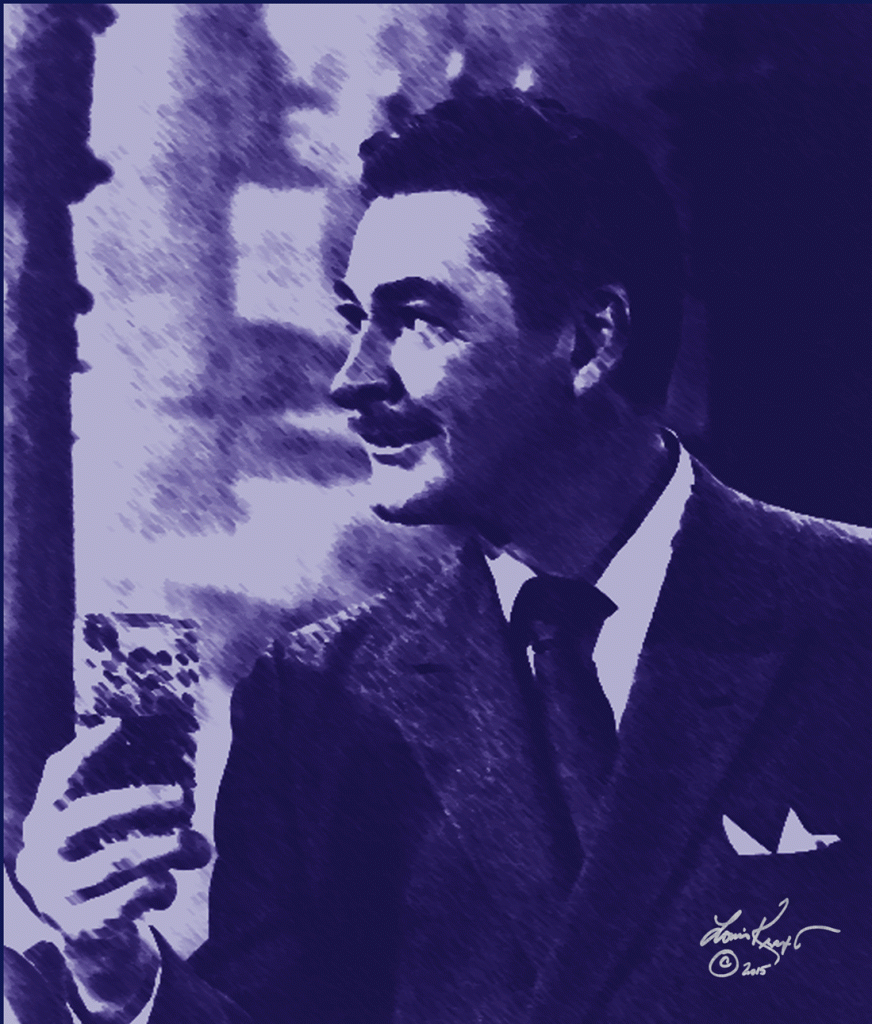
Errol Flynn as John Barrymore. Often it has been said that Flynn played Flynn in Too Much, Too Soon. I don’t know enough about John Barrymore’s life to know if this is true, but I intend to find out. For the record Flynn talked about how he played “Jack” Barrymore. (art © Louis Kraft 2015)
Bob Ellenstein played a key supporting role in Flynn’s Too Much, Too Soon, and of course I asked him about what it was like to work with Flynn (to this point in time I hadn’t seen the film). Bob’s lawyer entered the picture after Flynn’s John Barrymore had died. The answer was not what I wanted to hear: “My scenes were shot on days that he didn’t work. I never met the man.”
As the years passed and as Bob and I became close we shared more and more about our lives and as we did he guided me. … Acting is a lifelong study for a person must come in total contact with his or her being. That sounds simplistic; it is not. It is hard work. At one point Bob said to me while talking about the acting and film world, “Whatever you do, make sure that you can live with it.” I took this to heart. For the record I have never done anything that I can’t live with, and let me tell you that I have been presented with many unsavory propositions that would make you sick. I have never given in for the cost was way too expensive for my living soul.
An image of Mr. Flynn & yet another attack
On the late afternoon and evening of October 17, 2015, I was lucky to spend prime time with people from my past—people that shouldn’t be in my past, but friends that are still part of my life. It was a reunion, and honestly, if it wasn’t for a good friend of mine named Pete Senoff I probably would have passed, Thanks Pete, for it turned into a special time.
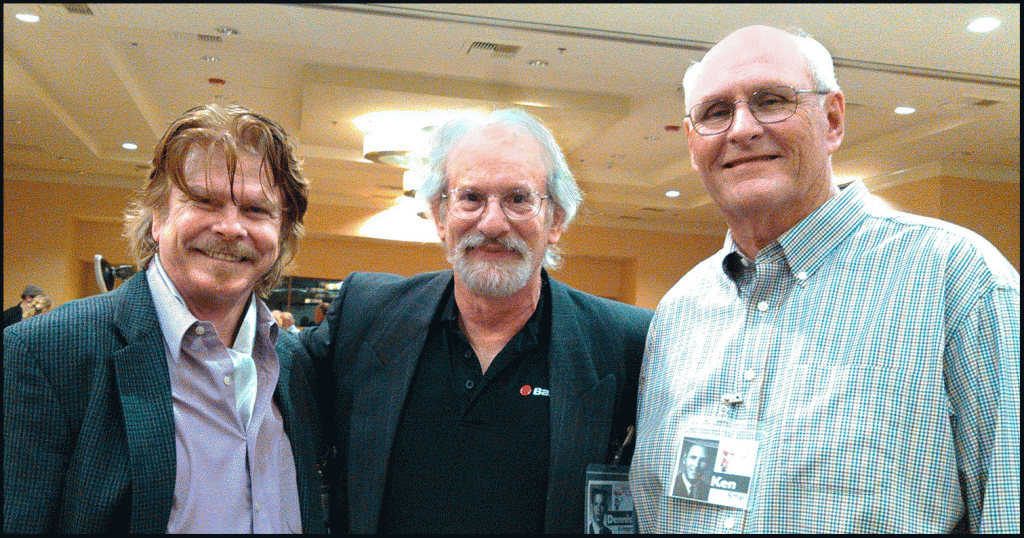
From left: LK, Dennis Kreiger, and Ken Small at our high school reunion at the Sheraton Agoura Hills Hotel on 17oct2015. A good time for LK. (photo © Pailin Subanna-Kraft)
Dennis Kreiger and Ken Small went to the last two years of elementary school with me, the three years of high school, and Dennis spent at least a couple of years with me in college. Ken became a police officer in Los Angeles and eventually a chief of police in Florida and then in Huntington Beach, California. Dennis had a successful tennis business in Encino, California, for decades. They are two of the good guys out of my past and present. I don’t know if they knew who they would become, but I didn’t know my future. Early on I did well with writing and essays but it didn’t mean anything to me.
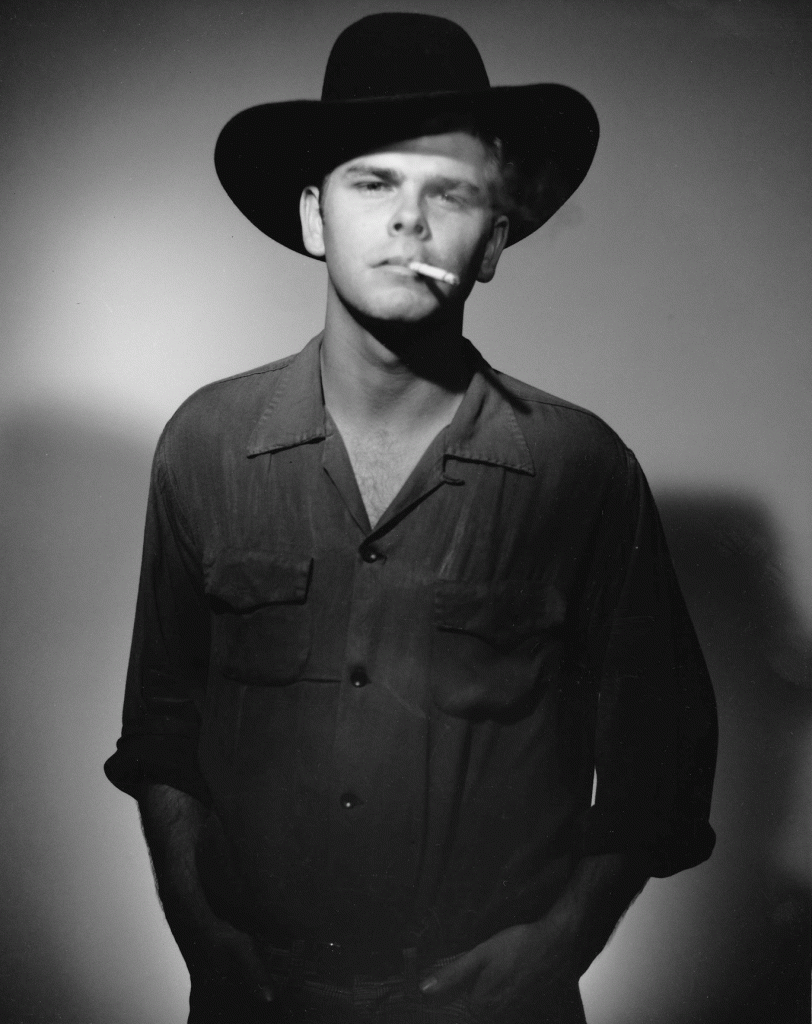
Former friend Dennis Riley, who was then a photographer’s mate in the U.S. Navy, shot this publicity photo in June 1969 at my parent’s house in Reseda, California, shortly after I completed my American Indian anthropology class, graduated from college, and began pursuing a career in acting. Oh yeah, broad-brimmed hats and I go way back. (photo © Louis Kraft 1969)
In my last semester in college I talked my way into an upper division anthropology class (with absolutely zero anthropology background). The professor gave in and I enjoyed myself in a class that dealt with American Indians that ranged from Alaska south into Central or South America. We had a term paper and I wrote about a young Apache’s journey into manhood. The professor set up a meeting between us. “Your paper is fiction,” she said. “It was supposed to be nonfiction.” “The instructions didn’t say that,” I replied. Her eyes looked up to the heavens. She shook her head, perhaps in the hope that I would go poof and disappear. I didn’t. Finally she chuckled and smiled. … I did quite well in that class. Still, I’m certain that if another hustler approached her without any anthropological background he would have fled for his life as she let loose with unbridled determination to never again deal with an outsider to the study of humankind.
Even when I wrote a screenplay about a shocking 1976 summer of acting in dinner theater (me), drugs (not me), racial prejudice, and bald-faced hatred wherein I was thrilled to escape the Lone Star state in one piece I still didn’t have a clue of what my future might hold. … Actually it had been preordained and was in place at least as early as 1970, and that experience was more horrifying, but as usual it didn’t register in my brain. Moreover, I still hadn’t realized what type of person Errol Flynn really was. This would still take me another decade or two to learn.
I once wrote an article entitled “The Image of Errol Flynn” (Films of the Golden Age, Spring 2000), and even though I had made it clear the article dealt with Flynn in the 1940s letters to the editor attacked me for not including Flynn in the 1950s. Often editors will ask writers of articles to respond to letters to the editor. I should say that I hate letters to the editor for often they are written by people that don’t know what they are talking about. In this case I simply said to the editor that there was no reason to reply as the ridiculous statement was out of scope of the article. … This hasn’t always been the case with some of my articles published in Wild West. These comments have often been flavored by racism or hatred toward me, but often I haven’t had to reply as I have viewed the comments an open invitation to attack. The editor, Greg Lalire, is first class and a good friend, but at times he walks a fine line between reality and insanity. More than once he has taken care of the problem offline (that is not in print or online). I love this! In 2014 an attack struck from a place that it shouldn’t have (and those reasons won’t be exposed until I go on an offensive that will initiate a war, a war a number of magnificent historians want me to start). Will I? Honestly, I don’t know. Guts Kraft, you need to trust your instincts and expose the lies and deception!
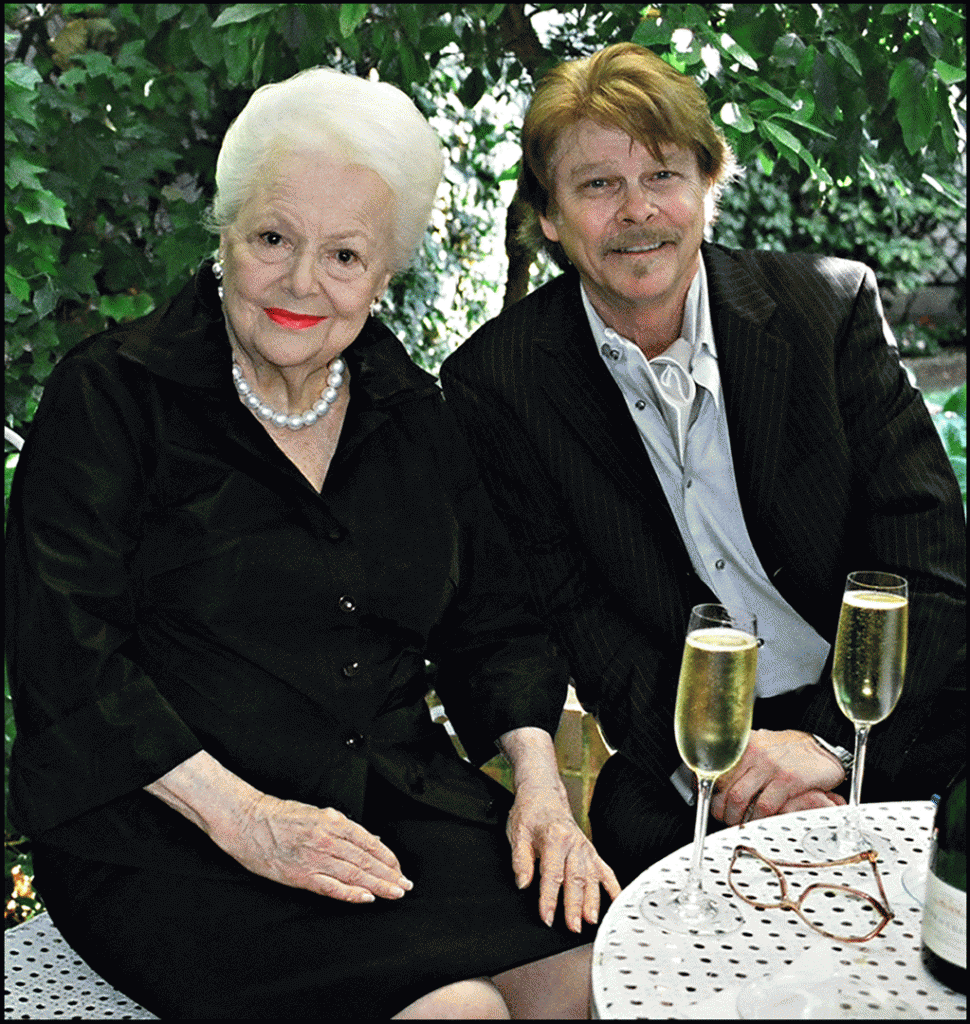
LK enjoying champagne with Olivia de Havilland (“OdeH” as I often call her and “Livvie” as Errol Flynn often called her) at her home in Paris, France, in July 2009. The lady is alive, funny, informative (when she wants to be but secretive when she thinks it is best), bright, charming, and oh-so-sexy. Livvie is alive and I hope that she outlives me. For the record, she has been burned by unscrupulous writer-historians and agrees with my views on Errol Flynn. (photo © Louis Kraft 2009)
What I have just stated above has also been true with so-called historians that write about Errol Flynn. They view him as open season, and fabricate facts and quotes while often citing obscure documentation that is hard to obtain at this late date. Worse, their facts and quotes are at times fiction (or, if you will, lies), with their lone goal to mislead their readers. You do not want to hear my opinion of these people, and I am using the word “people” here very loosely for these hacks aren’t “people.” I’m not going to call them what I know they are in this blog. Most likely I’ll never call them what they are, but I have every intention of exposing their fraudulent writing that has been created to destroy a human being’s life and reputation long after the fact without valid proof. As far as I’m concerned this is a heinous crime.
Back to the swashbuckling image
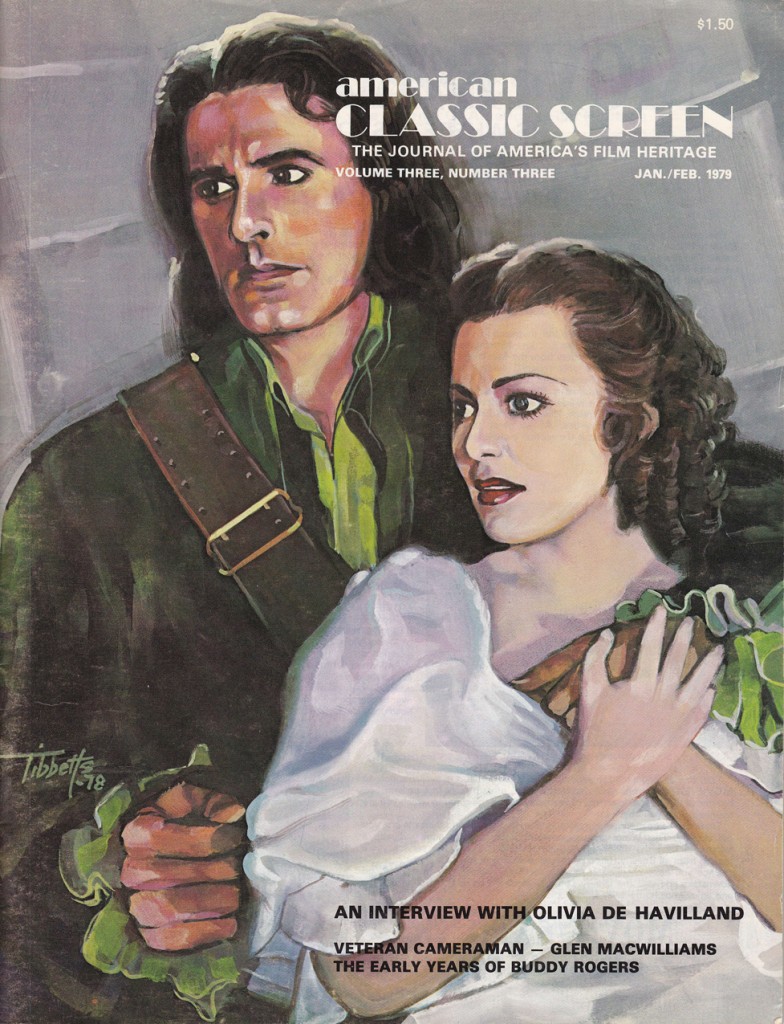
A classic magazine cover; alas, they don’t make them like this anymore. This isn’t quite true, for Wild West magazine is moving to art for their covers (and this is something that I like).
Beginning with the release of Captain Blood (based upon the first portion of Rafael Sabatini’s novel, Captain Blood: The Odyssey, Houghton Mifflin Co., 1922) in New York City in December 1935 Errol Flynn became an overnight sensation—a superstar* if you will—and his co-star Olivia de Havilland became a star (but not as bright as she would have liked). Warner Bros. realized that they had struck gold with the Flynn and de Havilland combination and began looking for another epic to cast them in; it would be The Charge of the Light Brigade (1936), inspired perhaps by Alfred Lord Tennyson’s epic poem of vainglorious defeat. Again the film was adventurous as it mixed a little history with a lot of fiction. Unfortunately a love triangle bogged the story down. Nevertheless Warner Bros. confirmed what they already knew—the combination of Errol Flynn and Olivia de Havilland in an epic romance meant big bucks at the box office. But for some unknown reason Warners ignored what they knew and began casting Flynn in films that were little better than melodramas in scope and delivery. Except for The Prince and the Pauper, but here Flynn was little more than a supporting player with a magnificent duel at the end of the film. By the end of 1937 Warner Bros. had finally realized their error of splitting Flynn and de Havilland apart. After almost making a major casting flub (casting James Cagney as Robin Hood), someone woke up and suddenly Errol and Olivia were once again cast together in a major motion picture. Filming on The Adventures of Robin Hood began in fall 1937.
* The word “superstar” was first used in relation to a great cricket team in the 1830s. Almost a century passed before it was used to describe great hockey players between the years 1910 and 1920. More decades would pass until the word hit its stride as we now know it today, but that wasn’t until long after Errol Flynn’s time.
One thing stood out in the 1930s and it is still true today—Errol Flynn appeared very natural on film. It, for the most part, looked like he wasn’t acting, and in a time when many actors came from the stage and their performances looked like acting, Flynn didn’t overact. At times the critics would chew on him for his naturalness, and judging by comments that he made over the years this hurt and bothered him.
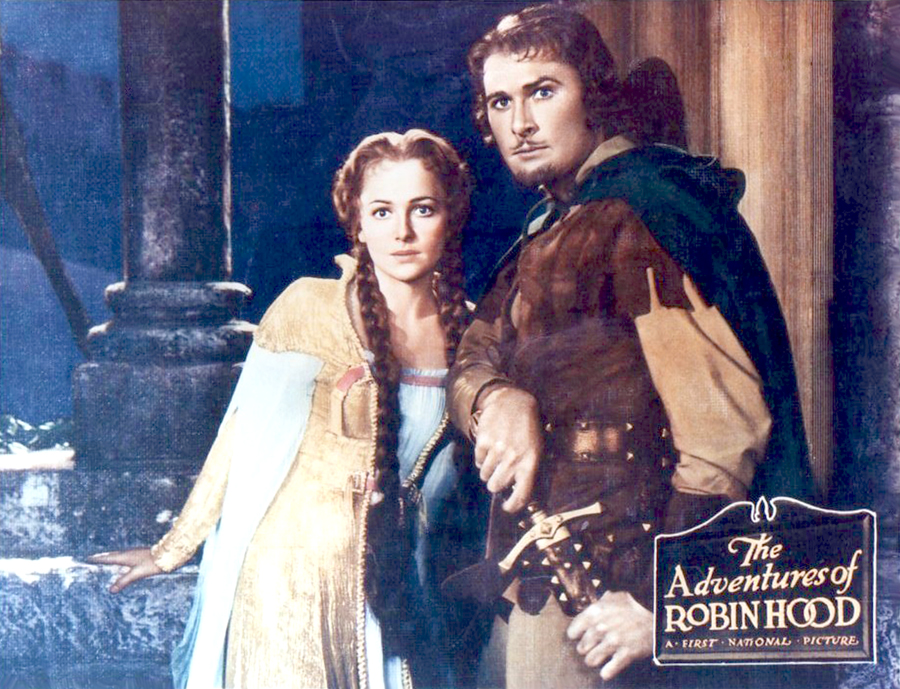
This is an original lobby card from the 1938 release of The Adventures of Robin Hood. (LK personal collection)
Oh, there were times when he did overact, such as in a scene in The Adventures of Robin Hood where his eyes go from left to right (or was it right to left?) in a closeup as he supposedly took in lay of the land (as to where Sir Guy of Gisbourne’s (Basil Rathbone) soldiers were waiting to jump him. I’d bet my life that this ridiculous closeup was insisted upon by the director. Actually one of two directors: William Keighley and Michael Curtiz, as I believe both had a hand in the major episode sequence in which the cut that I’m talking about is located in the film. I’ll have to go back to the script and match the closeup number with the call sheets to see when the shot was made.
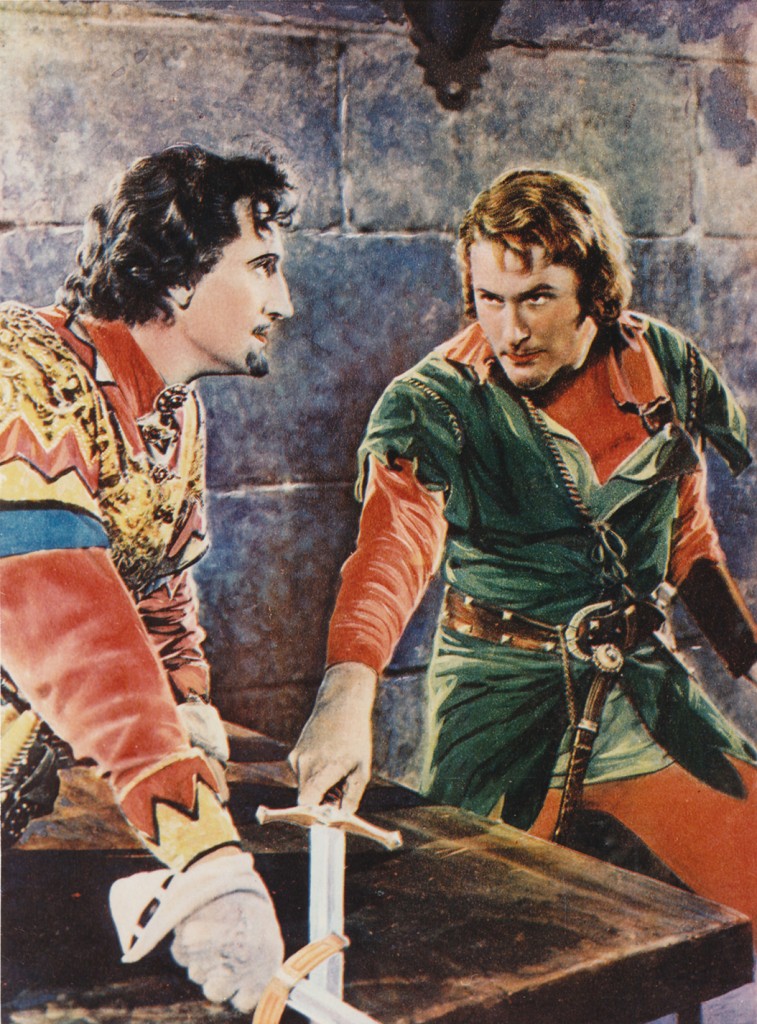
Published art based upon a studio still of the Rathbone and Flynn final duel in The Adventures of Robin Hood. I think that it is pretty good work by the artist that created it. (LK personal collection)
With the release of The Adventures of Robin Hood Flynn’s stature rose to new heights. I above discussed a shot that bothered me; there are others. That said, Flynn is magnificent as Robin Hood. His physicality and athletic ability is present at all times as is his capability with the sword. … My problem here is major, for no one can handle broadswords as presented in The Adventures of Robin Hood and I know this for I have swung a broadsword that was made of material that was considerably lighter than steel. It isn’t easy and there is absolutely no way that anyone can swing a broadsword as shown in Flynn’s 1938 film. That said, Flynn’s handling of the sword in that film was extraordinary (albeit they are rapier cuts and slices and thrusts). Basil Rathbone loudly proclaimed that he had studied the sword and “could have killed Mr. Flynn whenever I wanted.” (I hope that this quote is close; if not, it is a paraphrase). You want to know something? If in reality it was a duel to the death between Rathbone and Flynn, my money’s on Flynn. Reason: Rathbone was swinging the blade by the numbers. If what I just said is true, Rathbone was a student fighting with technique while Flynn fought to survive (and he had plenty of survival skills that dated back to his days in New Guinea … not to mention his dueling lessons that dated to Captain Blood). Again, and without batting an eye, my money’s on Flynn.
Alas, it will take three books to deal with Flynn’s swashbuckling and western and war and human experience films. If it becomes obvious that I won’t meet my goal of three full-fledged nonfiction books on his life I have every intention of writing a lightweight volume or two (similar to Tony Thomas’s superior film histories and genre-specific tomes w/photos books). This is easy for me. All the research is in place and I’ve got tons of images. This could be accomplished in half a year per volume (my average nonfiction book takes at least five to seven years to write when it is a major project). … If something happens and suddenly time becomes short I will move to plan B.
Mounting up with Mr. Flynn
In My Wicked, Wicked Ways Flynn called himself “the rich man’s Roy Rogers.” I didn’t check to see if I have the quote correct or if I have paraphrased it here. I’m not certain if he was talking about later in the cycle of his eight westerns or not.
A surprise named Dodge City
If memory serves me, and I didn’t dig for this blog (that said, I know Flynn), Mr. Flynn questioned being cast in a western film when he became aware that Warner Bros. was preparing a western to fit his screen persona (Dodge City, 1939).
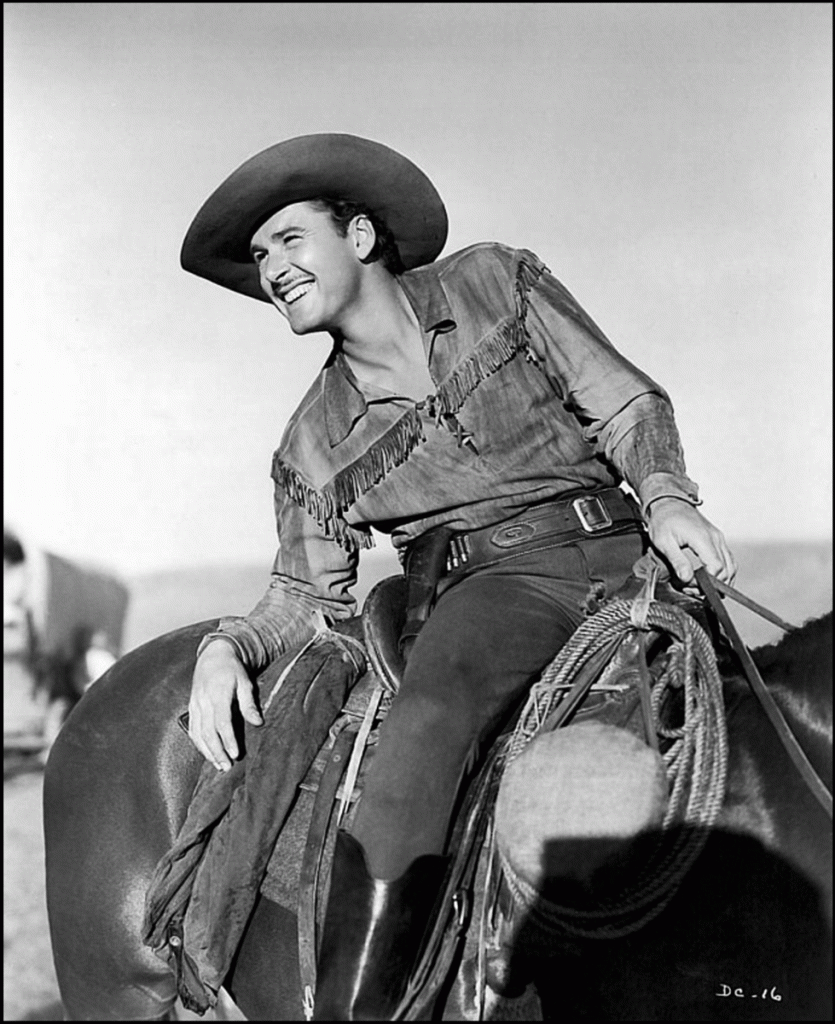
A relaxed and smiling Errol Flynn on the first or second day of Dodge City location filming. (photo in LK personal collection)
Of course he hadn’t done any research on the western expansion as the United Stated pushed to make the country extend from the Atlantic Ocean to the Pacific Ocean. He didn’t think that an Australian accent was present on the western frontier. Actually all accents were present on the western frontier and Mr. Flynn fit the mold of the adventurers that went a-westering to find fame and fortune. Trust me when I say the following, … Errol Flynn was more believable than the multitudes of “cowboy” actors that have been little more than clichés since the beginning of film. I’m certain that he would have enjoyed hearing this during his lifetime. He didn’t. If I meet him in the hereafter I’ll tell him this.
Like my knowledge of the sword I know the western experience. Actually a hundredfold more than the sword. I know race relations, I know the people that ventured West, I know the American Indians (certainly the Cheyennes, Arapahos, Apaches, and Navajos), and I know the people that attempted to end racial war (I’m upfront and center with this topic).
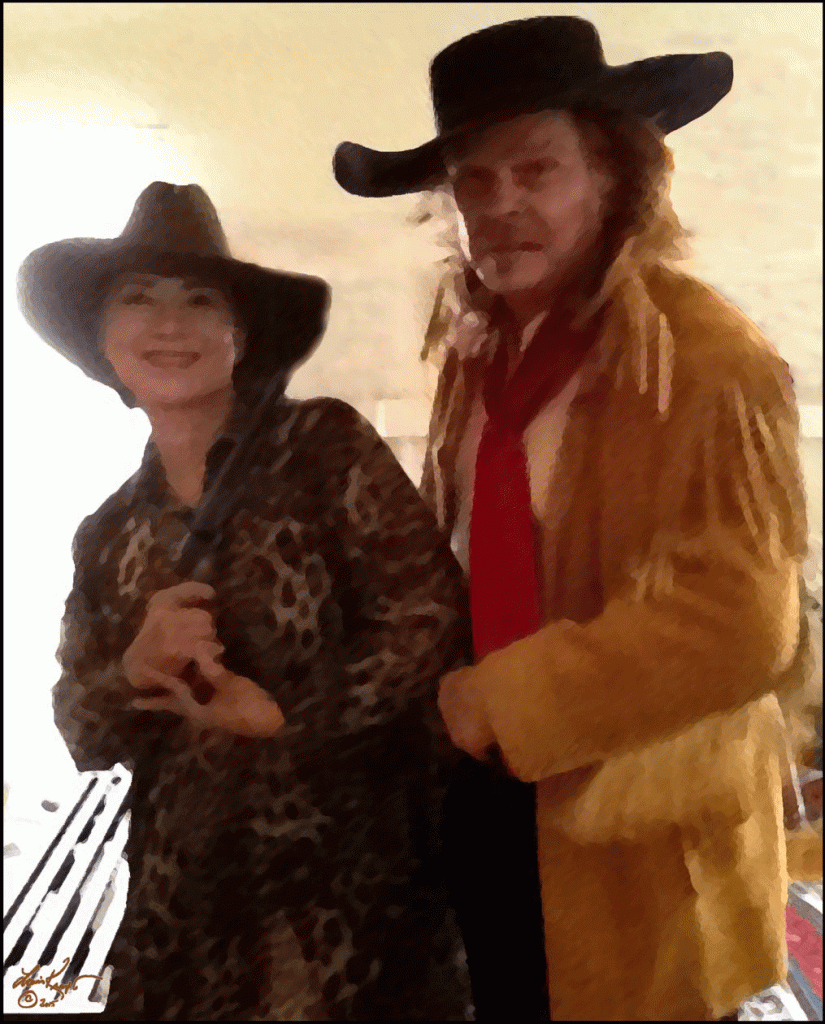
This art was created from a recent photo of Pailin Subanna-Kraft and LK. She’s my pistol-packing lady and I’m Mr. Hickok. BTW, the hair was mine as I needed useful photos with long hair. It was recently clipped for an event but don’t rule out the return of long tresses for now that it is gone I miss it. (art © Louis Kraft 2015)
Although I don’t write about the gunmen, I know a hell of a lot about James Butler (Wild Bill) Hickok (who, if I get lucky, I’ll someday play on stage), John Wesley Hardin, and Doc Holliday. Errol Flynn would have fit in with all of these people, and if he lived in the 1860s or 1880s he would have been a survivor. His performances in western films, except for his next to last, Montana (1950), are all acceptable. Three are exceptional (Dodge City; Virginia City, 1940; and They Died with Their Boots On, 1941), two are acceptable (San Antonio, 1945, and Rocky Mountain, 1950), and one I cannot comment about (Silver River, 1948) as I haven’t seen it in decades. … While still on the subject of who I’d like to play on stage, add Errol Flynn to the list. In the case of Hickok and Flynn I need to convince my director and producer to buy into the project (which I’d write). The Flynn project would be original but the Hickok project would be based upon a great novel, East of the Border, by Johnny Boggs (and in this case I also need Boggs to buy into the project).
| “Must See, Must Read” Five intriguing books and five films about the Indian Wars by Louis Kraft* Wild West (August 2014) |
| “They Died With Their Boots On (1941, on DVD, Warner Home Video): If Errol Flynn hadn’t played George Armstrong Custer, there would have been no Kraft writing about the Indian wars. Long years past through present day, critics of this film have pounded it for its historical inaccuracy. Although true, let me invite you to actually research it—which I’ve done since the mid-1990s in preparation of multiple books on Errol Flynn (the first to be called Errol & Olivia). The thrust has been simple: In 1941 Warner Bros. feared being sued, and historical players and facts changed to fiction. Even though the film is fiction, it is so close to truths that have been disguised and altered that it’s scary. I can’t list them here, but trust me, for ’tis true. Don’t buy it? Do your own research. … Errol Flynn’s performance as George Armstrong Custer is magnificent, for he captured the spirit of the man; and Olivia de Havilland is perfect as Libbie Custer. It is arguably Flynn’s best performance, and by far their best performances in the eight films they did together.” |
| * This column is ongoing in Wild West (by contributors to the magazine). Usually five books and five films have mini reviews. I made my comments personally related to my writing career. This issue also included two other LK articles. One, a feature, “Wynkoop’s Gamble to End War,” was, I believe, the best article that I have written about Ned Wynkoop. |
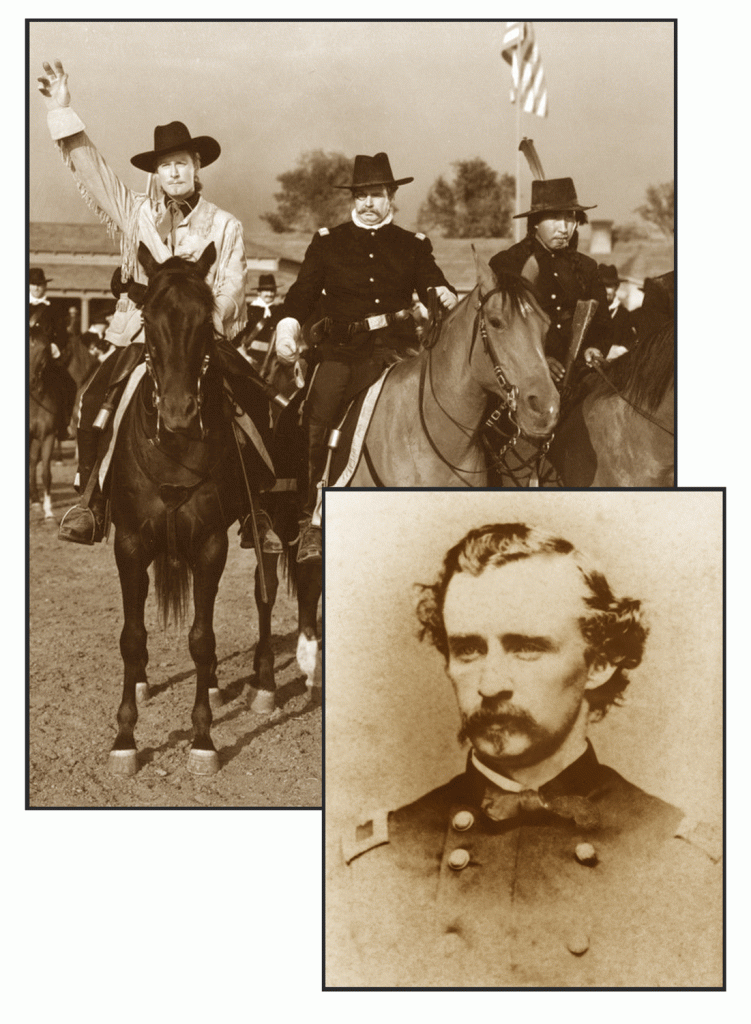
Errol Flynn as George Armstrong Custer in They Died with Their Boots On just before he sets out for Montana Territory and destiny, and the real Custer 11 years before his death at the Battle of the Little Bighorn. For the record Custer set out from Fort Abraham Lincoln in Dakota Territory on his final Indian campaign on May 17, 1876. He didn’t engage Sioux, Cheyenne, and Arapaho Indians on the Little Bighorn River until June 25, 1876. This fact is here for, believe it or not, people have stated to me numerous times that Custer fought his final battle a day or two after setting out. (both images are in the LK personal collection)
Already this blog is fairly long and I don’t want to expend another four thousand or more words here. If you’ve read my Flynn articles you know what I think about They Died with Their Boots On (my best Boots article appeared in the June 2008 issue of American History). There had been a pitch to True West to write short articles on all eight of Flynn’s western films (which had been accepted at the time of the pitch in June 2012) but then, suddenly, as I prepared to deliver the first article the idea was dropped by the magazine. My view of the change without notice: Bullshit, which I made known. Because of this I’m on True West’s “S–list” and have no intention of again pitching them with another story idea. They can pitch me and if the story idea is acceptable to me I’ll write it for them (ditto, Wild West), but I have no intention of pitching True West until this less-than-savory event is resolved to my satisfaction. Wild West is another story, but it, too has something that we need to resolve. … Add that book writing is my major concern and honestly I don’t give a damn if I ever write another magazine article. Hell, I’m never going to write for Oracle or Yahoo! again (and they paid me a hell of a lot of money)—why should writing for True West or Wild West be any different (and they pay peanuts)?
Hey, that’s life. … At least that is my life at this date in time.
For the record Errol Flynn looks like he was born astride a horse. This was evident in Captain Blood, The Charge of the Light Brigade, and in all of his westerns (except for Montana).
The goal has been to hopefully catch your interest in Errol Flynn, but not to write a book within a blog.





